ZePrA | Auto Setup EN
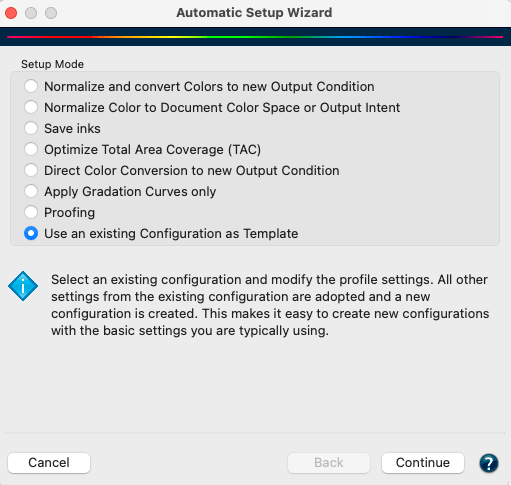
Auto Setup
Workflow Creation
ZePrA provides several auto setup methods to set up workflows for the most common color management tasks. The Automatic Setup Wizard also allows workflows that save ink, optimize the total area coverage (TAC), apply gradation corrections and proofing. It takes just a few steps to create Configurations and Queues.
To process files, either use a previously created DeviceLink profile, or use the SmartLink function to create a DeviceLink profile on-the-fly (SmartLink license required).
Setting Up Workflows with the Auto Setup Wizard
Select Auto Setup in the sidebar. There are seven different setup options for creating Configurations and Queues. The first two modes involve normalizing the data. General Information about Normalizing Data can be found further down this page.
Select a Setup Mode
Normalize and convert Colors to new Output Condition
The content of the PDF file is first normalized to the document color space or output intent and then converted to the desired target color space.
PDF files usually do not contain any information about the document color space. If there is no PDF/X file available for Normalization but only a PDF file, decide on a Document Color Space into which any existing ICC-based PDF objects will be converted.
There are two options to choose from:
- Use existing DeviceLink Profile
Choose a DeviceLink profile for the configuration (e.g. from our DeviceLink sets, available from any ColorLogic dealer), and select it from the drop-down menu. The source and target profiles are set by the DeviceLink profile.
- Use SmartLink
The SmartLink function creates DeviceLinks on-the-fly from source and target profiles.
Note: Requires a SmartLink license. If the SmartLink function is not available, normal ICC conversions are performed for objects with embedded ICC profiles.
For more information, see DeviceLink or SmartLink further down on this page.
Select the rendering intent for the calculation. More information can be found further down this page under Rendering Intent.
Prefer Output Intent: The output intent of the PDF/X file is used instead of the manually set document color space.
SmartLink Method: Defines the conversion settings. There are predefined methods available for traditional printing, large format printing, and digital printing, but custom methods can also be used.
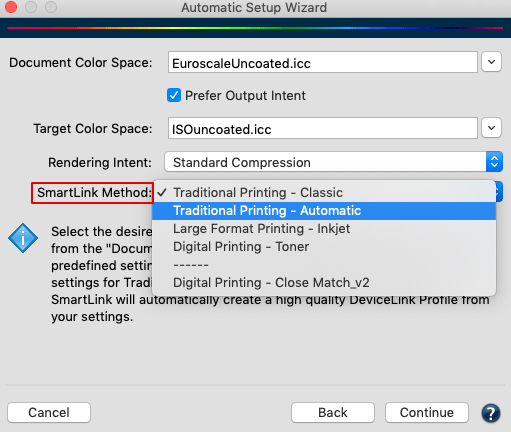
Data processing:
RGB objects with embedded profiles are first converted to the document color space (normalized). If the SmartLink function is activated and an individual PDF object contains an embedded device profile, the device profile is used to create a DeviceLink profile on-the-fly. Embedded rendering intents are also considered. When normalizing, all images without embedded profiles are converted to the document color space based on the predefined profile.
CMYK objects with embedded profiles are first converted to the document color space (normalized). If the SmartLink function is activated and an individual PDF object contains an embedded device profile, the device profile is used to create a DeviceLink profile on-the-fly. The conversion is then performed using this DeviceLink profile.
If a Relative Colorimetric rendering intent is embedded in a PDF object, Auto Setup automatically activates the Blackpoint Compensation to ensure clean reproduction of details in the shadow areas.
Exception: PDF 2.0 files – see Black Point Compensation with PDF 2.0 files under Configurations/Options/Rendering Intents.
If the DeviceLink profile was created using the option to preserve pure primaries and secondaries, pure colors are kept pure in CMYK objects with embedded profiles.
To ensure precise color conversions, ZePrA completely recalculates the conversion of source and target profiles on-the-fly. The algorithms used are identical to those used in ColorLogic’s CoPrA profiling software.
There are five additional rendering intents available for SmartLink to avoid inharmonic color conversions that can result from differently calculated tables for source and target profiles (see Rendering Intents).
If SmartLink has not been licensed, a direct ICC-based conversion to the target profile or document color space is performed. This can contaminate pure CMYK colors, which can cause problems with overprinting elements.
The automatic setup wizard’s option to normalize first and convert afterwards provides the most consistent results for color conversions, as recommended by the PDF/X specification.
The default name of this queue starts with Convert.
Normalize Color to Document Color Space or Output Intent
The data is standardized, i.e. it is converted to the document color space or output intent (normalized).
For PDF files, all ICC-based PDF objects are converted from the embedded ICC profile via the embedded rendering intent to the document color space (output intent). After this step, all objects of the PDF file are color-matched to a consistent standard (document color space/output intent).
PDF files usually do not contain any information about the document color space. If there is no PDF/X file available for Normalization but only a PDF file, decide on a Document Color Space into which any existing ICC-based PDF objects will be converted.
After conversion, the final, normalized file consists only of a document color space and spot colors, if present.
If a Relative Colorimetric rendering intent is embedded in a PDF object, Auto Setup automatically activates the Blackpoint Compensation to ensure clean reproduction of details in the shadow areas.
Exception: PDF 2.0 files – see Black Point Compensation with PDF 2.0 files under Configurations/Options/Rendering Intents.
The following color conversions are performed during normalization:
- Conversion of device RGB and ICC-based RGB objects to document color space
- Spot colors remain unchanged (can be converted to the target color space if required)
- Conversion of ICC-based CMYK to document color space, retaining pure colors and separation properties (when using SmartLink)
- Assignment of ICC-based gray to the black channel of the document color space (prevents four-color gray)
The default name of these queues start with Normalize.
Save inks
The data is first normalized to the document color space and then optimized using either an existing SaveInk profile or a SmartLink SaveInk method. Three Ink Saving methods are available.
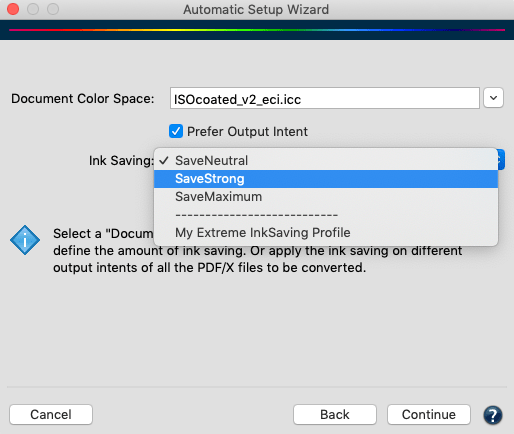
Selecting an Ink Saving method
The Save inks setup mode is available when the source and target profiles are identical. The optimized file remains in the same color space. The focus is on accurate color reproduction while reducing CMY inks and increasing black ink (K).
Use existing DeviceLink Profile: Select an existing SaveInk DeviceLink profile from the drop-down menu. ZePrA only shows profiles whose source and target profiles are identical.
Use SmartLink: Select the profile which matches the Document Color Space and choose from three standard Ink Saving methods (SaveNeutral, SaveStrong, SaveMaximum). It is also possible to define custom SaveInk settings in CoPrA and share them with ZePrA. These custom SaveInk settings are displayed below the dashed line (My Extreme InkSaving Profile in the screenshot above).
SaveNeutral: Moderately increases the amount of black in the neutral color ranges.
SaveStrong: Increases the proportion of black strongly.
SaveMaximum: Maximum ink savings with colorimetrically still very high accuracy while retaining the visual color impression.
Calculate Ink Savings: The Automatic Setup Wizard can calculate the ink savings for processed files. However, this calculation can significantly slow down processing. If faster data processing is desired, deactivate this option.
Note: The ink saving calculation can be enabled or disabled under Configurations/Options.
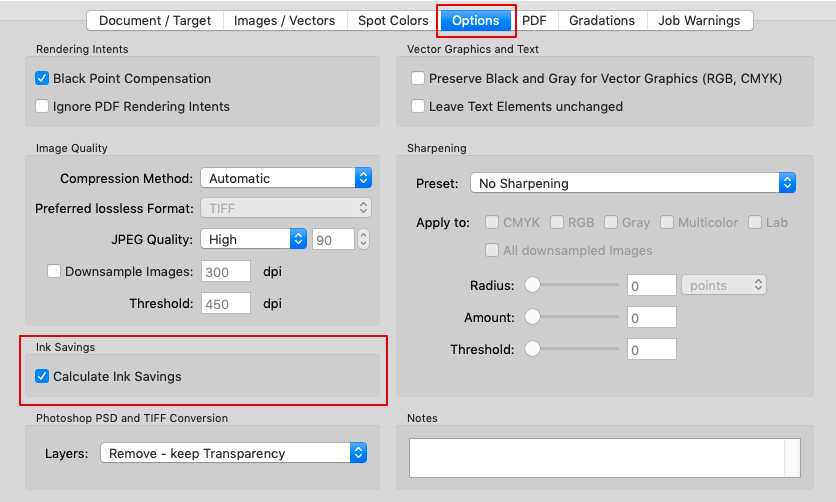
The default queue name starts with SaveInk.
Optimize Total Area Coverage (TAC)
The data is normalized to the document color space and the total amount of ink is reduced. This can either be done by using special profiles to reduce the total area coverage (TAC), or – if SmartLink is used – by specifying the Desired TAC value.
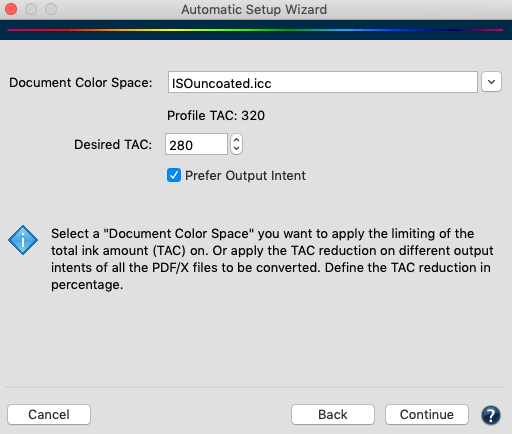
Adjusting the maximum ink coverage
The source and target profiles must be identical. The optimized file remains in the Document Color Space. The focus is on accurate color reproduction while reducing ink coverage.
Choose from two options:
- Use existing DeviceLink Profile: Select an existing TAC reduction DeviceLink profile from the drop-down menu. ZePrA only displays profiles with identical source and target profiles.
- Use SmartLink: Assigns a TAC to the selected Document Color Space on-the-fly (requires a SmartLink license).
Prefer Output Intent: The output intent of the PDF/X file is used instead of the manually set Document Color Space.
The default name of these queues starts with TAC.
Direct Color Conversion to new Output Condition
The data is directly converted to the target color space using embedded profiles, without normalizing to the document color space beforehand. This setup mode enables the maximum color space utilization of the target color space and is particularly suitable for media-neutral data, e.g. RGB image data with ICC profiles, or image file conversions (TIFF, JPEG, PSD). It is particularly well-suited for use with Push-2-ZePrA.
If the profile embedded in the file matches the profile defined as Document Color Space, the profile setting defined in the Document/Target tab is used instead of the settings in the Image/Vector tab.
In addition, the rendering intents of the PDF are ignored (the Ignore PDF Rendering Intent checkbox in the Options tab is enabled) and the rendering intents defined in the Image/Vector tab are used instead, which usually leads to an improved color rendering for direct color conversions.
Select either Use existing DeviceLink Profile or Use SmartLink.
Use existing DeviceLink Profile: Select a DeviceLink profile that converts from the document color space to the required output condition. All other settings for RGB, CMYK, Gray and Lab color spaces are set automatically.
Use SmartLink: Select the respective ICC profiles under Document Color Space and Target Color Space to create the DeviceLink on-the-fly. Define the intended Rendering Intent and the SmartLink Method that best fits your workflow process.
RGB objects with embedded profiles: Converts directly to the target color space and utilizes the maximum color space, however, the embedded profiles and the selected Rendering Intent are taken into account. This guarantees a consistent conversion and optimization of the data.
RGB data without embedded profiles: The sRGB color space is used, which can be changed in the configuration, if necessary.
In general, Blackpoint Compensation is enabled when the embedded intent is Relative Colorimetric.
CMYK objects with embedded profiles: The SmartLink function optimizes direct color conversion via the DeviceLink profiles. Embedded profiles/intents are considered.
The default queue name starts with Output.
Apply Gradation Curves only
Gradation adjustments apply external files on-the-fly to existing curves, adjusting process colors and/or spot colors without changing the document color space.
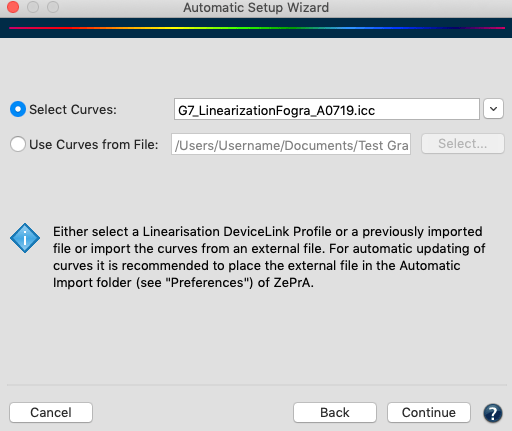
Gradation curves are a simple solution for applying gradation corrections to print-ready PDF/X-1a files consisting of CMYK and spot colors only.
There are two ways to correct gradations:
1: Select Curves
Select Linearization DeviceLinks created by CoPrA or previously imported files including curves (gradations). Previously imported files will be shown beneath the linearization DeviceLink profiles.
Gradation curves created with CoPrA’s Linearization tool are saved in the Profiles folder (/User/User name/Library/ColorSync/Profiles oder C:/WINDOWS/system32/spool/drivers/color/) and are automatically listed in ZePrA’s Select Curves drop-down menu. Only curves with a matching color space are shown. These curves are read only and cannot be edited with ZePrA’s Gradations tool. When changing the gradation curves (e.g. by overwriting the .icc file in CoPrA with differing linearization data), these changes will automatically be applied to all configurations using these curves. The location of the selected .icc file is not relevant (e.g. Profile or Auto Import folder).
2: Use Curves from File
Loads an external file that includes the gradation corrections for the process color(s) to be changed.
Gradation curves created with ZePrA’s Gradations tool are saved in the Profiles folder and are automatically listed in the Gradations tab drop-down menu under New/Edit. The curves can also be accessed by Load Curves/Use Curves from File . When changing the gradation curves with ZePrA’s Gradation tool, these changes will automatically be applied to all configurations using these curves.
Normalize and Document Color Space
Normalize: PDF/X-3 or PDF/X-4 files that contain RGB or CMYK objects with embedded profiles are normalized and the curves are applied to the normalized file.
Document Color Space: Define an ICC profile as the document color space for files with no output intent defined in the PDF file. Activate the Prefer Output Intent checkbox to ensure that any existing output intent always takes precedence over the specified document color space and is thus retained.
The default name for these queues starts with Gradations.
Proofing
ZePrA’s sophisticated technology – e.g. the quality of DeviceLink and SmartLink profiles and the spot color rendering of its advanced spot color module – can be used for proofing as well. This is especially useful as many RIPs do not support CxF/X-4 data and SCTV calibration nor have a spectral color prediction model for spot color rendering.
Procedure
Select Proofing under Setup Mode to create a proofing queue.
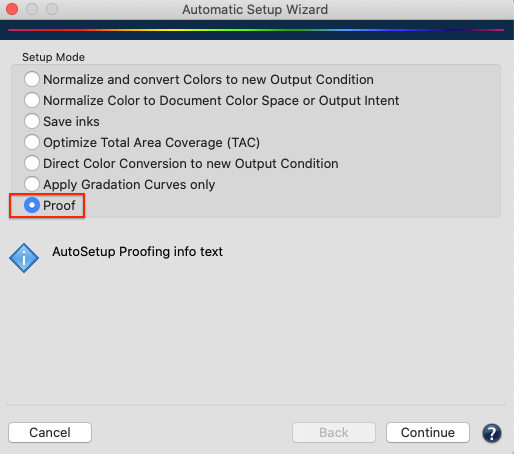
Select either an already created DeviceLink profile for the proof workflow – this can be an iterated DeviceLink profile created by CoPrA – or use SmartLink to create a proof DeviceLink based on your simulation profile and the proofer profile.
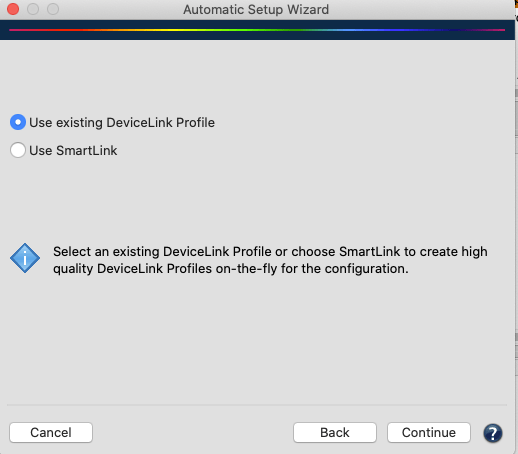
Use SmartLink: The DeviceLink for proofing is created “on-the-fly” based on the Simulation Color Space and the Proofer Color Space. Activate the checkbox Prefer Output Intent to use the output intent of the PDF/X file.
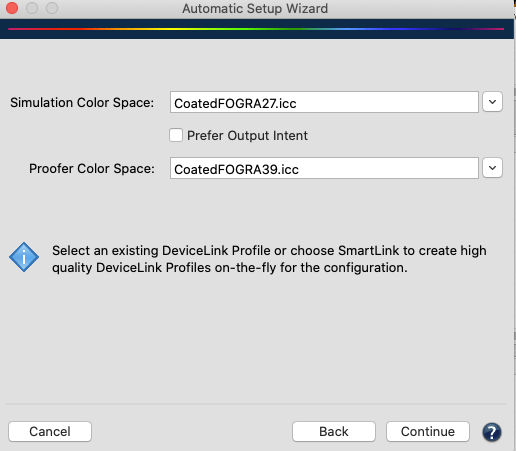
At this point you don’t have to select a rendering intent or SmartLink method as the appropriate settings will be set automatically to achieve best results (e.g. absolute colorimetric rendering and the use of no color exceptions). This includes typical settings for transparency flattening and spot color conversions, too.
If required, the settings can be customized under Configurations once the configuration has been set up, for example to select the desired spot color library for spot color conversion.
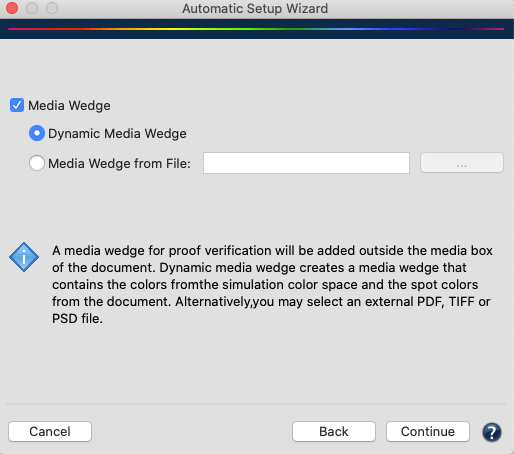
Select a Media Wedge. The media wedge is added outside the media box for proof verification. It can either be a dynamic or an external media wedge.
Dynamic Media Wedge: Uses the colors of the simulation color space and all spot colors of the documents to be processed.
Media Wedge from File: Can be media wedges such as the FOGRA, UGRA, IDEAlliance® or other media wedges (as PDF, TIFF or PSD file).
Note: External media wedges need to be provided (and possibly bought from organisations) by the user. The Idealliance ISO 12647-7: 2013 control wedge for CMYK, Idealliance-3-Row-Digital-Control-Wedge® is available for free. The Idealliance ISO 12647-7 Control Wedge 2013 is included in ZePrA and available under /Users/Shared/ColorLogic/MediaWedges (Idealliance ISO 12647-7: 2013, 3-Row Digital Control Wedge® is a registered trademark of the IDEAlliance®).
Create the proofing configuration and queue:
Confirm the Queue Name suggested by ZePrA or enter a custom name.
Specify the Base Folder in which the queue is to be created. To create a Queue (Hotfolder) in the Base Folder, activate the Create Queue checkbox and the corresponding subfolder will be created.
To only create a new configuration, uncheck the Create Queue checkbox. The new configuration can be assigned to an existing queue in the Queues dialog later if required.
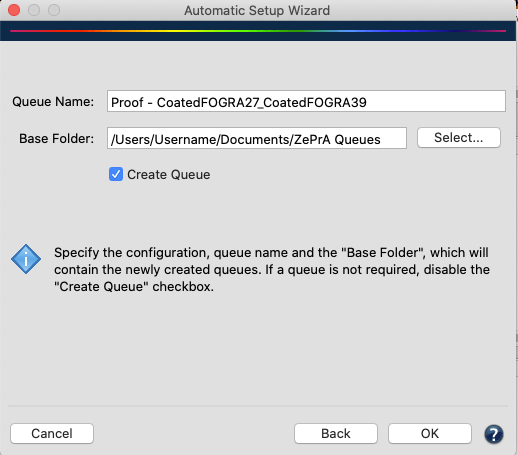
Use an existing Configuration as a Template
This Setup Mode uses an existing configuration with all custom settings as a template to create a new valid configuration with only the profiles adjusted. Depending on the profile adjustments made, the settings are modified accordingly to ensure proper functionality of the new configuration:
- When the Document Color Space has changed, the default profile used under Images/Vectors is changed accordingly.
- Iterated spot colors are removed when the target profile has changed (they are kept when the target profile has not changed).
- Correction profiles are deactivated when the target profile has changed (they are kept when the target profile has not changed).
- PDF/X settings are changed when the target profile has changed.
Procedure
First, select the existing configuration to be used as a template. The dialog provides some information about the profiles used as Document and Target Color Space, the Conversion Method, and the configuration Type.
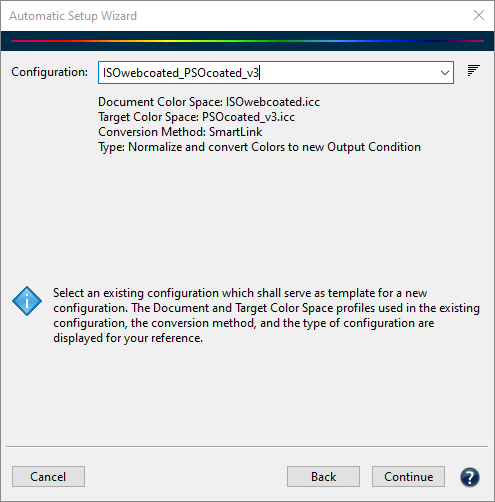
In the next step, new profiles can be selected, which must be of the same color space and type as the original profile, e.g., if the base configuration uses a DeviceLink as the conversion method, the wizard will only allow DeviceLinks to be selected, if the base configuration uses SmartLink, the new configuration will also use SmartLink, etc.
Note: In contrast to the above restriction, when using a SmartLink configuration with Multicolor target profile, Multicolor profiles with other color spaces can also be selected as the new target profile. This is particularly helpful if the Multicolor profile variants created by CoPrA are to be used in ZePrA.
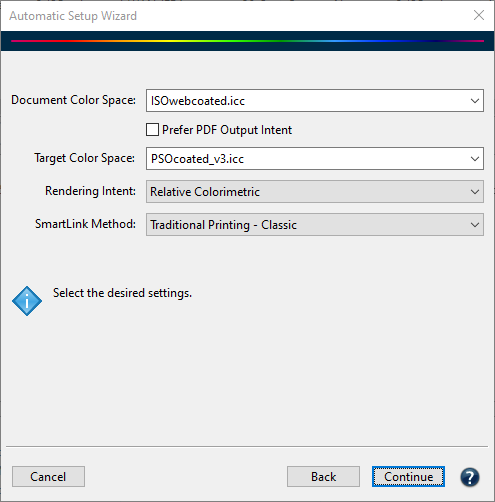
Finally, create the new configuration and queue:
Confirm the Queue Name generated by ZePrA or enter a custom name.
Specify the Base Folder in which the queue is to be created. To create a Queue (Hotfolder) in the Base Folder, select the Create Queue checkbox and the corresponding subfolder will be created.
To only create a new configuration, deselect the Create Queue checkbox. The new configuration can be assigned to an existing queue in the Queues dialog later if required.
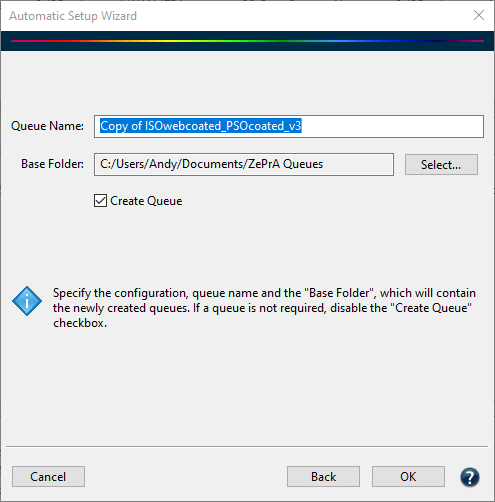
DeviceLink or SmartLink
DeviceLink or SmartLink
Either use an existing DeviceLink profile in your configuration or use SmartLink to create and use a high-quality DeviceLink profile within the workflow.
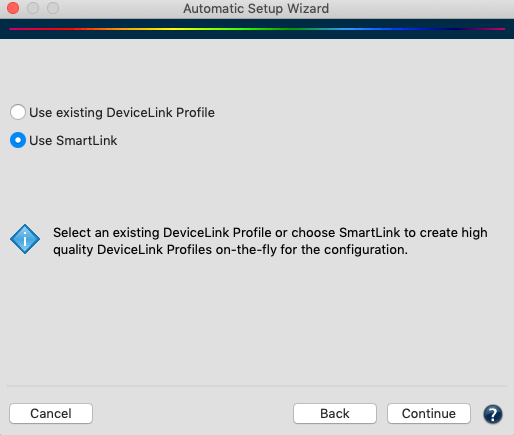
Use existing DeviceLink profile or SmartLink
Use existing DeviceLink Profile
If files are processed without embedded profiles, and there is a matching DeviceLink profile, you can use it within your workflow. This DeviceLink profile then defines the source profile and the target profile.
Select the DeviceLink Profile to be used for conversion from the document color space to the target color space. All relevant PDF/X information is automatically transferred. (For more information, see Configurations – PDF/X)
In the Save inks and Optimize Total Area Coverage (TAC) modes, the drop-down menu DeviceLink Profile only lists profiles with identical source and target profiles.
Use SmartLink
The DeviceLink for the conversion is created “on-the-fly” based on source and target profiles. The Rendering Intent for the calculation can be selected manually. Instead of the manually set Document Color Space, read out and use the output intent of the PDF/X file by activating the Prefer Output Intent checkbox.
The SmartLink option creates high quality DeviceLink profiles to avoid the problems of typical ICC conversions and ensures optimal color conversions.
Sharing settings with ZePrA (CoPrA 5 and lower)
Due to the close connection between CoPrA (ColorLogic’s profiling solution) and our color server ZePrA, the profile settings from CoPrA can be used to calculate DeviceLink profiles in ZePrA.
By selecting the checkbox Share with ZePrA in CoPrA, the settings of your DeviceLink and SaveInk profiles are transferred directly to ZePrA and can be used there as SmartLink Method.
The SmartLink Method in ZePrA allows calculation of the necessary DeviceLink and/or SaveInk profiles for the conversion of PDF files on-the-fly, without the need to create these DeviceLinks in advance.
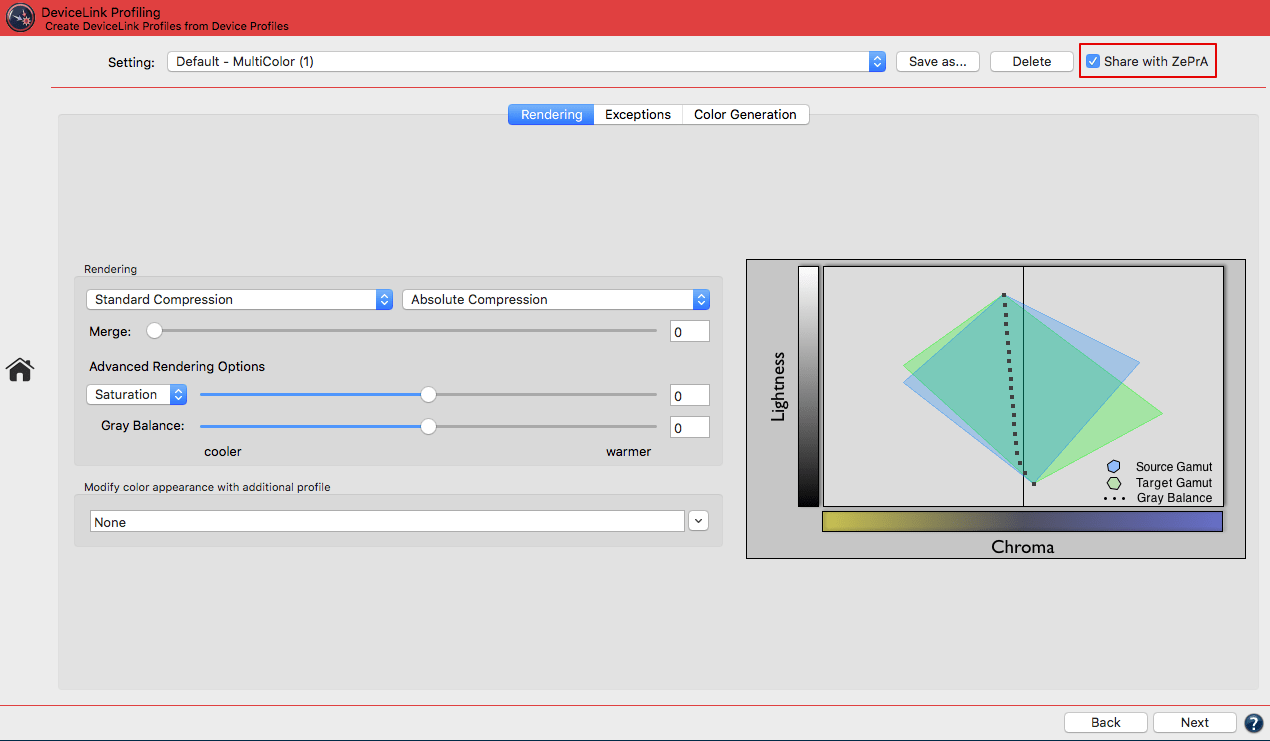
The DeviceLink tool in CoPrA: SmartLink can use the profile settings from CoPrA to create DeviceLinks in ZePrA
To do so, make all the required settings in CoPrA by entering all relevant information in the DeviceLink tool under Rendering, Exceptions, and Color Generation. Click Save As and enter a name for the setting. Confirm with OK, then activate the Share with ZePrA checkbox.
The so created methods shared with ZePrA are then available as SmartLink Method in the drop-down menus of both the Auto Setup and the Configurations.
Note: Only saved settings can be shared with ZePrA. Default or edited presets cannot be shared.
Sharing settings with ZePrA (CoPrA 6 and higher)
The SmartLink Method in ZePrA allows to create DeviceLinks and SaveInk profiles for the conversion of PDF files on-the-fly, without the need to create these DeviceLinks in advance.
Due to the close linkage between CoPrA and ZePrA, profiling settings specified in CoPrA can be used by ZePrA to create the required profiles.
The settings are accessible via a shared folder which has the advantage that CoPrA and ZePrA do not need to be installed on the same computer. The shared folder must simply be accessible by both ZePrA and CoPrA, either over the network, a shared local folder or the cloud.
Procedure
In CoPrA
- Under Preferences, enable the checkbox Share CoPrA Settings with ZePrA Auto Import Folder and select ZePrA’s Auto Import folder.
Note: The Auto Import folder must be activated in ZePrA as well.
If the checkbox is enabled and the Preferences dialog closed with OK an information message will appear asking the user if all shared presets should now be copied to the defined Auto-Import Folder.
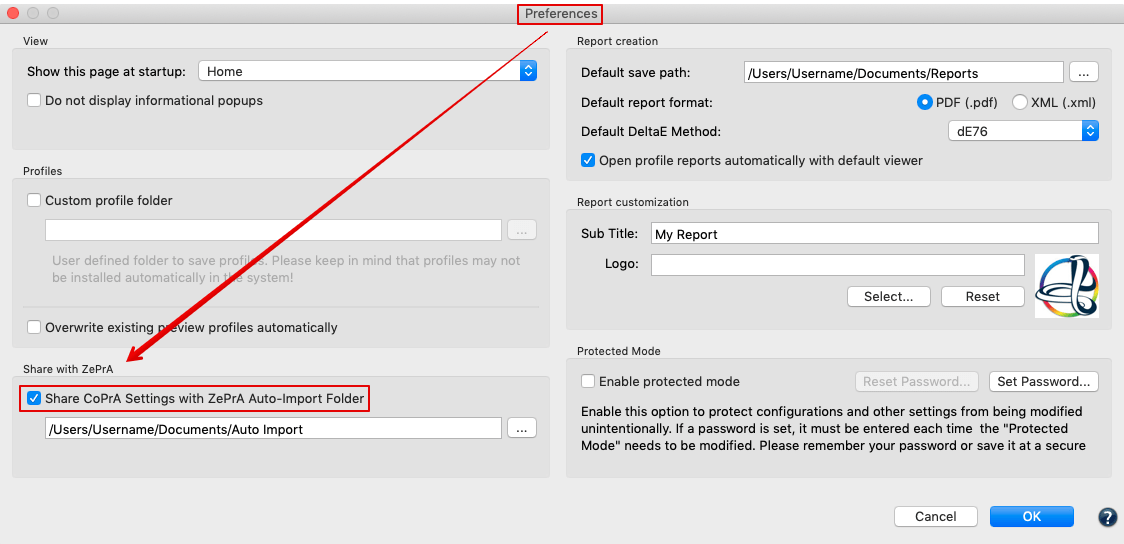
- In the DeviceLink tool, define all required settings by entering all relevant information under Rendering, Exceptions and Color Generation.
- Click Save As and enter a name for the setting. Confirm with OK, then activate the Share with ZePrA checkbox.

- CoPrA Settings created that way and shared with ZePrA are available for selection as SmartLink Method in the drop-down menus of both the Auto Setup and the Configurations settings.
Note: Only saved settings can be shared with ZePrA. Default or edited presets cannot be shared.
In ZePrA
Make sure to enable the Auto Import function in ZePrA’s Preferences and to use the same folder as CoPrA. CoPrA’s DeviceLink and SaveInk settings are now accessible in ZePrA and can be used there as a SmartLink Method. SmartLink can now create custom DeviceLinks which can be used in ZePrA configurations.
Basic information on the Auto Import folder
Files (such as ICC profiles, configurations, spot color libraries, gradations or SmartLink settings) that are moved or copied into the Auto Import folder are transferred to ZePrA’s internal dataset and can then be used by ZePrA.
When the file in the Auto Import folder is replaced by a newer version, it will be updated in ZePrA’s internal datasets as well.
Note: If a file in the Auto Import folder is deleted, it is not deleted in ZePrA’s internal dataset. For example if a SmartLink setting has been deleted in the Auto Import folder, it is still available in ZePrA’s internal dataset and if this setting is deleted in ZePrA’s dataset, it is still available in the Auto Import folder.
Document Color Space
The document color space serves as a reference to define a uniform color space for the colors of the PDF file.
- CMYK color spaces are usually used for print production, as CMYK colors are generally used for printing.
- RGB document color spaces are suitable for modern publications for mobile media.
- Multicolor color spaces are often used in packaging printing or in modern digital printing.
ZePrA supports the full spectrum of color spaces (Multicolor color spaces require a Multicolor license). Individual RGB or CMYK objects with embedded profiles in PDF files are converted to the document color space. For professional print production, data exchange should always be based on the PDF/X standard.
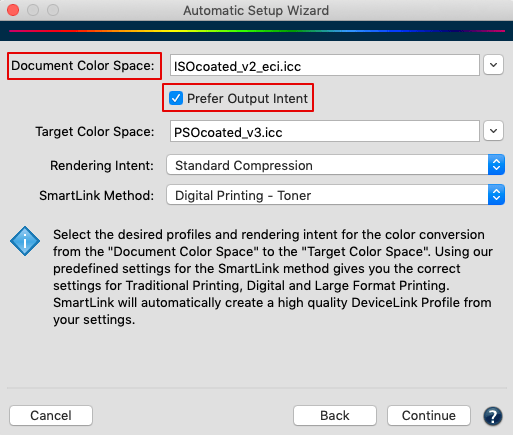
Prefer Output Intent
By activating this checkbox, the output intent of the PDF/X file is used instead of the manually set Document Color Space.
In addition to the ICC device profiles of individual PDF objects, an output intent can be defined for the entire PDF document (an ICC device profile that describes the document color space).
The document color space in PDF/X documents is clearly defined as the output intent.
If Prefer Output Intent is activated, PDF/X files with various output intents can be correctly converted in a queue because the respective output intent is considered instead of the document color space.
Note: This function is only applicable for PDF/X files.
Target Color Space
The Target Color Space is defined by the target profile selected in the drop-down menu. If necessary, the target profile can be changed here.
A PDF/X file whose Document Color Space/Output Intent does not match the color space of the final printing process requires the entire PDF file to be converted from the Document Color Space to the Target Color Space. The best conversion quality is achieved by using high-quality DeviceLink profiles (e.g., created by CoPrA) or SmartLink.
If CoPrA profiles with viewing conditions other than the standard are selected as Target Color Space (e.g., D65 and 10 degrees, as typically used in textile printing), this is indicated by a light bulb icon.
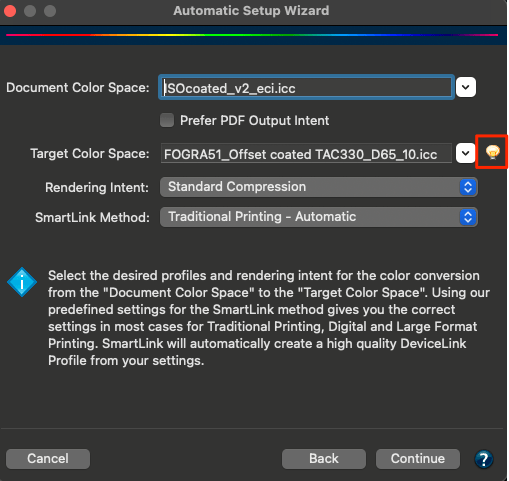
When hovering the mouse pointer over it, the Viewing Condition (e.g., D65, 10 degrees) is displayed and the wizard automatically sets this Viewing Condition in the CIE Conversion. The light bulb icon is also displayed in the Configuration dialog next to the profile drop-down menu for selecting the Target Color Space.
Note: The light bulb icon only appears for non-standard viewing conditions. The viewing condition can be changed manually in the configuration. However, this could have undesirable consequences and cause a workflow warning.
Rendering Intent
General information on the design of ICC device profiles
Rendering intents, such as Perceptual or Relative Colorimetric, contain large tables which, for example for CMYK profiles, convert either CMYK color values to Lab or Lab color values to CMYK.
Due to these two color conversion directions, there are two tables for each rendering intent. The tables are calculated from the measurement data when a color profile is generated.
If ICC device profiles are calculated from the same measurement data, but with different profiling programs, then the tables generated can differ considerably in some color ranges.
This is especially true for the two tables of the Perceptual intent, for the gray balance and also for the areas with very high color saturation in the two tables of the Relative Colorimetric intent (also called “Out of Gamut” colors).
For optimal and harmonious color conversion, it is recommended, especially with CMYK-to-CMYK color conversions, to ensure that the source and target profiles were calculated with the same profiling software.
However, profiles from different providers (such as Adobe, ECI or ColorLogic) are often used in practice, which can lead to problems in color conversions if the perceptual rendering intent is used.
These problems can be avoided by using SmartLink.
The SmartLink module uses the source profiles embedded in PDF or image data and automatically calculates the DeviceLink profile required for conversion between source and target for each object and applies it at object level. The main conversion from the document color space to the target color space is also carried out via SmartLink. SmartLink is ideal for processing external data from a wide variety of sources to ensure optimum color accuracy (via DeviceLinks).
Additional SmartLink Rendering Intents
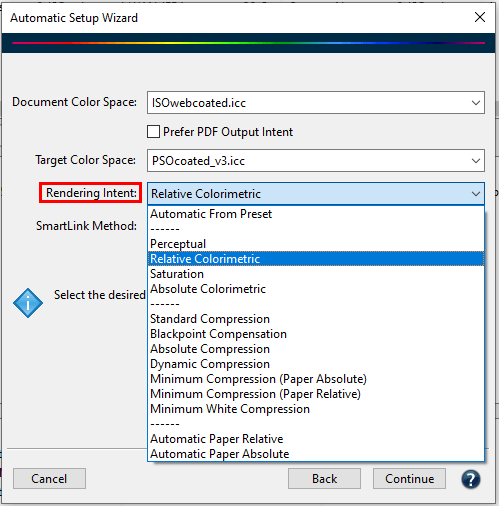
There are several additional Rendering Intents for SmartLinks
The SmartLink module provides several additional rendering intents to avoid inharmonic color conversions, which can result from differently calculated tables for source and target profiles.
To ensure precise color conversions, ZePrA completely recalculates the conversion of source and target profiles on-the-fly. The algorithms are the same as ColorLogic’s CoPrA profiling software.
Note: These additional rendering intents are only available with SmartLink enabled. If the checkbox Use SmartLink is not activated or SmartLink has not been licensed, only the four standard rendering intents are available.
Automatic from Preset: This option is for Custom SmartLink Methods shared from CoPrA and takes whatever setting has been selected in the shared DeviceLink setting from CoPrA, including the rendering options, like a merge between two rendering options, chroma or saturation boosts, all exceptions and black generation settings.
Note: Automatic from Preset is only available in the drop-down menu when a custom SmartLink Method is selected. So, first select a custom SmartLink Method and the option Automatic from Preset will be on top of the list.
Note: In earlier versions of ZePrA (9 and lower) it is not possible to merge two different rendering options for color conversion, because the rendering settings of a profiling setting shared from CoPrA are always overwritten by the rendering setting selected in ZePrA.
Standard Compression: This is the default method. It uses a perceptual conversion that is well suited for all types of gamuts, i.e., also for conversions between color spaces of different sizes. Neutral tones are converted using a relative colorimetric approach, and the appearance of the gray axis always depends on the paper white of the target profile. Therefore, the gray axis of the transformed file will appear yellowish on a very yellowish paper. The same gray axis will appear bluish on a bluish paper. For very small color gamuts, for example in newspaper printing, the dark tones are raised slightly to achieve more image definition in these areas.
Black Point Compensation: Use Black Point Compensation to achieve the same results with a perceptive conversion as with “Relative Colorimetric with Black Point Compensation”. When converting from large to small color spaces, the image definition is preserved in the highlights and shadows, unlike with a pure Relative Colorimetric conversion. Neutral tones are converted using the Relative Colorimetric intent. Out-of-gamut colors are cut off.
Absolute Compression: This method is based on the absolute colorimetric rendering intent in terms of color reproduction and is recommended when the paper tones differ significantly (the color gamuts can be similar or different). In contrast to the Standard Compression and Black Point Compensation, the paper tint is compensated in the gray balance. The rendering of neutral colors is based on the absolute colorimetric rendering intent, without paper tone simulation in the highlights. If, for example, the paper white is significantly more yellow than in the reference, the gray axis appears neutral despite the yellowish paper tone. This ensures that the color appearance of the original file is preserved as best as possible on a target medium with a different paper tint. The contrast range in the highlights and shadows is adapted to avoid any loss of image definition.
Minimum Compression (Paper Absolute): This method is largely similar to the absolute colorimetric intent and only compensates close to the black and the white point.
In addition, the white point of the source color space is not simulated, but scaled to the white point of the target color space, thus ensuring a pure paper white.
Use this rendering intent to achieve a close reproduction, for example when using print standards such as ISO Coated V2 or GRACoL2006 Coated1v2 on a digital printer.
Note: As for the absolute colorimetric rendering intent, ensure that the target color space is larger or has at least a similar size to avoid any loss of image definition. For color conversions from larger to smaller color spaces use Absolute Compression to maintain the gray balance of the source color space.
Minimum Compression (Paper Relative): This method is largely similar to the relative colorimetric intent and only compensates close to the black and the white point. It is similar to Minimal Compression (Paper Absolute) but uses relative colorimetric instead.
Dynamic Compression: Compares the source color space with the target color space and generates a compression that minimizes out-of-gamut areas. This setting preserves the brightness of the original color space while reducing the saturation, and therefore also preserves the image definition. As for the Standard Compression, the gray axis of the conversion is built relative to the paper white of the target profile. This approach is well suited when the source and target profiles have a very large dynamic range and contrast, for example, in RGB-to-CMYK conversions.
Note: This method is now only available in ZePrA for compatibility reasons, and no longer in CoPrA. We recommend using Automatic Paper Relative instead.
Minimum White Compression: This method is similar to Minimum Compression (Paper Absolute). Both rendering intents compress the white point without paper simulation, however, there is an important difference: The Minimum Compression is a rather perceptual rendering that additionally compresses the black point, so the maximum dynamic range is utilized without loss of detail in the shadows. In contrast, the Minimum White Compression compresses the white point but not the black point, so a close absolute colorimetric match between source and target color spaces can be achieved. This can be useful for the color representation across various media, color matching or printing on slightly differing media. It can be regarded as close to absolute colorimetric rendering without paper tint simulation.
Note: Remember that the target color space should be larger than the simulated color space (or similarly large) to avoid loss of detail and vividness (similar to the absolute colorimetric rendering intent). For conversions from large to small color spaces, instead use our rendering intent Absolute Compression if the gray balance of the source color space is to be preserved.
Important: To ensure that an on-the-fly DeviceLink profile created with SmartLink uses the rendering intent set under Configurations > Images/Vectors, activate the checkbox Ignore PDF Rendering Intents in the Options tab.

Automatic Paper Relative: A paper-relative rendering without adjusting the gray balance, which differs between the source and target profiles due to differences in paper tone. A typical use case would be a more colorful rendering of a color space on a different printer where the gray balance does not necessarily need to match. For example, a campaign that has been prepared for ISO coated V2 but is to be printed on a large format inkjet printer. The gray balance is reproduced with the same coloration as the paper color tone of the target profile.
Automatic Paper Absolute: An absolute paper rendering with consideration of the paper color tone. A typical use case would be the same as Automatic Paper Relative, but with the paper color tone of the source profile taken into consideration. This results in a reproduction of the gray balance on the target printer that matches the color tone of the source profile and thus provides the best possible color appearance.
Important: For PDF processing ZePrA typically uses the rendering intent defined in the PDF for each object. When deviating from this rule, ensure that an on-the-fly DeviceLink profile created with SmartLink uses the rendering intent set under Configurations > Images/Vectors, select the checkbox Ignore PDF Rendering Intents in the Options tab.
SmartLink Method
The SmartLink Method considers the different requirements of different printing conditions so the printed color is correctly reproduced and optimally separated for the printing process.
Traditional Printing – Classic: Conversions for offset, gravure, or newspaper printing. The DeviceLinks created ensure that black and gray, as well as the primary, secondary and triplex hues of the source profile, are preserved. The total area coverage is taken from the target profile.

Choosing a SmartLink Method
Traditional Printing – Automatic: Select this setting when the colors and paper of the target color space are significantly different from the output intent or document color space. Separation is preserved, but Exceptions for special colors such as black and gray, primary, secondary, and triplex colors are automatically calculated based on both profiles.
Large Format Printing – Inkjet: The separation is characterized by a strong GCR and a late black start. The black point and total area coverage are automatically calculated to ensure the best color reproduction. The Exceptions for special colors, such as black and gray, primary, secondary and triplex hues, are automatically calculated based on both profiles. To avoid problems that can occur when colors vary between different inkjet printers or between the inkjet printer and the source color space (as with ISOcoated V2 or GRACol), the Large Format Printing – Inkjet method automatically calculates the required exceptions in those cases.
Digital Printing – Toner: For toner-based digital printers and office printers. This method uses the same DeviceLink presets for Exceptions as Large Format Printing – Inkjet. The separation method ensures that a high percentage of black is used. This will achieve a stable print and neutral gray balance. The total area coverage is taken from the target profile. The Exceptions for special colors, such as black and gray, primary, secondary, and triplex hues, are automatically calculated based on both profiles.
Creating Queues and Configurations
Creating Queues and Configurations
- Enter a Queue Name that matches the name of the configuration.
- Specify the Base Folder in which the queue is to be created. To create a Queue (Hotfolder) in the Base Folder, activate the Create Queue checkbox and the corresponding subfolder will be created.
- To only create a new configuration, uncheck the Create Queue checkbox. The new configuration can be assigned to an existing queue in the Queues dialog later if required.
Note: Auto Setup overwrites configurations without warning.
If a configuration with the same name is to be overwritten, a warning only appears if the existing configuration or queue has different settings. If the settings are identical, the configuration is overwritten without warning.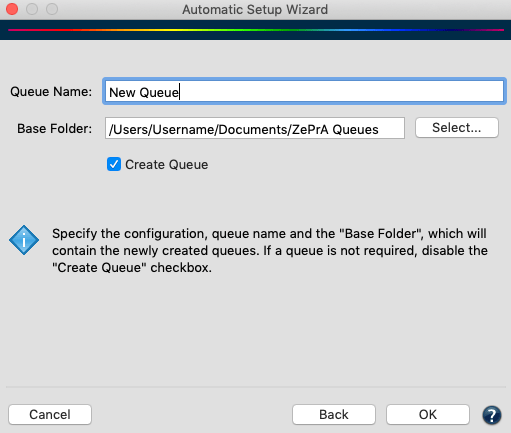
In the final step of the Auto Setup the queue is created along with all required folders
Configurations
All settings related to color handling and PDF processing are defined under Configurations. This includes color conversion via ICC output profiles or DeviceLink profiles, handling of mixed PDFs (documents with data in CMYK, RGB, Grayscale and spot colors) and individual settings of gradation curves and spot colors. Various presets and optimization options are available for all settings.
In the upper part of the window, select a configuration, create, rename and save new configurations.
To duplicate an existing configuration, select New, enter the new name and Save. To use a duplicated configuration, assign it to a queue.
Using Queues
The Automatic Setup Wizard simplifies the setup process, once complete, the new configuration and queue can be used immediately. To use a queue, simply copy or move the PDF file to be converted to the Input Folder of the queue.

The queue is automatically started by placing a file in the hotfolder
PDF files in the Input Folder are automatically converted according to the color management settings and saved to the Output Folder. Original files are moved to the Done Folder. Files that have caused an error are saved in the Error Folder.
General Information
General Information on Normalization
When a normalizing mode is selected, the Document Color Space is the same as the Target Color Space and no conversion between document and target takes place. However, all images and vectors color spaces deviating from the Document Color Space profile are first standardized, e.g., converted to the document color space or output intent. This is called normalization.
With PDF/X files, all ICC-based PDF objects are converted from the embedded ICC profile via the embedded rendering intent to the document color space (output intent). After this step, all objects of the PDF file have been converted to a consistent “standard” (Document Color Space/Output Intent).
PDF files generally do not contain any information about the document color space (Output Intent). If there is no PDF/X file available for normalization but only a PDF file, decide on a document color space into which any existing ICC-based PDF objects are converted.
After conversion, the final, normalized file consists only of a color space and spot colors, if present.
The following color conversions are performed during normalization:
- Conversion of device RGB and ICC-based RGB to document color space
- Spot colors remain unchanged (can be converted to the target color space if required)
- Conversion of ICC-based CMYK to document color space, retaining pure colors and separation properties (when using SmartLink)
- Assignment of ICC-based gray to the black channel of the document color space (prevents four-color gray)
Converting PDF files with Auto Setup
The easiest way to set up a color management workflow between various color spaces is to use the Auto Setup in combination with the SmartLink method. ColorLogic’s DeviceLink Sets (DLS) are also an option for standard color spaces. All sets are optimized so that the colors of both image and vector data of a PDF file can be reliably converted. The profiles are optimized and checked for smoothness and visually correct conversion, and have been proven in production.
All color information required for PDF/X is automatically set by Auto Setup, including the use of the target profile as output intent, normalization, and color conversion.
Gradients in vector graphics that consist of just one or two CMYK colors still contain only the original colors after application of the profile. The color values are merely adjusted for the output.
Example: If PDF objects are in the RGB color space and the Relative Colorimetric rendering intent is embedded, the Auto Setup queue automatically activates Black Point Compensation to ensure accurate detail reproduction in shadow areas.
Grayscale: Grayscale objects can be handled like CMYK, preserving gray and avoiding conversion to four colors. To do this, choose Use CMYK Conversion
from the drop-down menu Gray in the Images/Vectors tab under Configurations. If SmartLink is licensed, color conversions of objects with embedded profiles are always performed via SmartLink to ensure the best possible quality.

Spot Color: If the PDF files contain spot colors, they remain unchanged. To convert spot colors to process colors, the spot color settings must be adjusted under Configurations > Spot Colors.
Embedding profiles: By default, no ICC device profiles are embedded in the individual elements of the output file.
SmartLink: If the SmartLink function has been licensed, color conversions of objects with embedded profiles are always performed via SmartLink and use DeviceLink profiles in order to guarantee the best possible quality.
PDF Transparencies: If a PDF file contains transparencies, the individual PDF objects are processed in exactly the same way as the PDF files without transparencies. The colors of the transparencies are converted by default and the transparency information is preserved unchanged. If required the Transparency Flattening can be set in the configuration in the PDF tab under Transparency/Overprinting.
Flattening is mainly required for transparent objects if there are problems after conversion while maintaining transparency and when spot colors are to be converted to process colors.
Converting Image Files with Auto Setup
TIFF, JPEG, PSD, or PSB image data are processed in auto setup queues the same way as image data of a PDF file. The conversion is based on the settings under Images/Vectors and Document/Target.
For pure image data conversion of TIFF, JPEG, PSD and PSB images from a source color space to a target color space, it is recommended to use the Auto Setup option Direct Color Conversion to new Output Condition and select one of two options in the Automatic Setup Wizard:
Option 1: Use a previously created DeviceLink profile for the conversion of the image color space to the target color space. The DeviceLink chosen in the Automatic Setup Wizard should be set to source profile of the image, for situations where images without embedded profiles are processed. The target profile is set by the Auto Setup.
For images with embedded profile and images with other color spaces not defined under Document Color Space the settings under Images/Vectors are applied. Make sure to select the proper default profiles, the desired rendering intent and make sure that the checkboxes under Apply Embedded Profiles are enabled.
Option 2: Use ICC Profiles for document color space and target color space to calculate a DeviceLink “on-the-fly” via SmartLink, which requires a license for SmartLink. Choose the desired Rendering Intent and SmartLink Method for the calculation.
When using the SmartLink option, either a DeviceLink profile is created “on-the-fly” or a stored DeviceLink profile is used depending on the setting under Profile Assignments. Store the specific profile in the table in the Profile Assignments window to ensure that a specific DeviceLink profile is applied in the configuration.
Additional information regarding image files
ZePrA supports images with 8 bit and 16 bit color depth. The color depth of the input data is preserved with the conversion unless TIFF, PSD or PSB files are saved as JPEG files under Options/Image Quality. This will result in a color depth of 8 bit since only 8 bit is possible in JPEG files. Read more about this under Configuration > Options > Image Quality. ZePrA supports layers in PSD and TIFF files. Read more about this under Configuration > Options > Photoshop PSD and TIFF Conversion.
General Information
For high-quality color conversions, the source color space of the object to be converted should be known or readable. If no suitable document color space (ICC Output Intent) is assigned to the objects of the PDF file, the conversion is performed based on the document color space selected as source profile. Be sure to select a suitable document color space, as an unsuitable document color space will affect the quality of the conversion.
In most cases, Auto Setup converts PDF files to an output color space without assigning an embedded profile to each element. The output depends on the target profile (CMYK, RGB, Gray or Multicolor).
Data containing additional spot color information is not changed in a standard queue. All color information required for PDF/X is automatically set in Auto Setup, including the definition of the target profile as an output condition.
Auto Setup is great for creating queues for common color conversions. However, if the workflow requires special adjustments, changes can be made as needed under Configurations.
In the Queues chapter, you can learn more about how to handle the hot folders created by the Auto Setup Wizard or the Queues tool.
ZePrA | Preferences
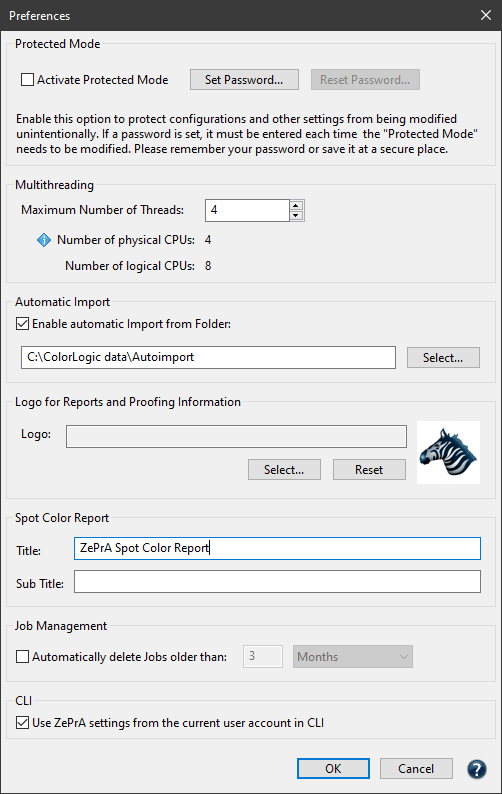
Preferences
Protected Mode
The Protected Mode prevents unintentional changes to configurations, queues, registration (and license) and other settings.
In Protected Mode new configurations cannot be created or existing configurations and queues cannot be edited using the Auto Setup Wizard. Importing configurations and changing the registration is also prevented. Only file processing and starting or stopping queues are possible.
If an action that is protected is to be performed deactivate the Protected Mode under Preferences.
The Protected Mode can be used with or without a password.
Set Password: Enter a secure password and confirm by entering it a second time. If a password has been set, it must be entered each time the protected mode is to be deactivated. To remove or change the password, click Reset Password.
Set password for Protected Mode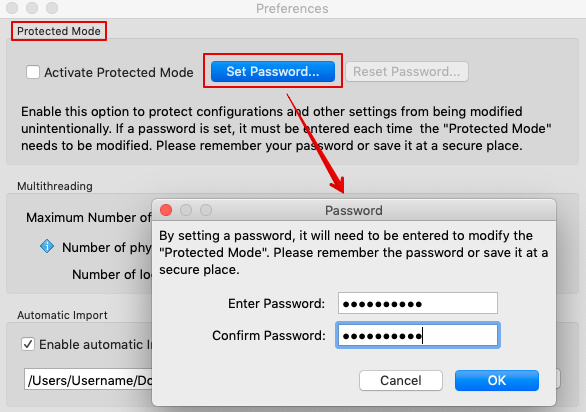
Multithreading
ZePrA works in 64-bit mode which allows the use of additional memory for simultaneous processing of multiple files. Thanks to multithreading, ZePrA supports modern multi-core CPUs and can process multiple files simultaneously. As a result PDF files are processed much faster. ZePrA uses the same number of threads as there are CPUs in the system by default. The number is shown in the number field next to Maximum Number of Threads and can be changed. However, the processing speed does not increase if you use more threads than CPUs available. It is recommended to use fewer threads so the system can use the computing power for other tasks.
Example: On a 4-core MacBook Pro with ZePrA 4 processing of 135 files with a size of 2.8 GB took 30 minutes, whereas ZePrA 6 and higher only take 7 minutes. Using 8 threads would slow down processing.
Setting the number of threads
Automatic Import - ZePrA's cloud function
When ZePrA is used on multiple computers within a company, the cloud feature Automatic Import allows sharing configurations and spot color libraries by deploying a shared folder in the cloud (DropBox, Google Drive, internal cloud) or on the internal network. The folder supports ZePrA’s spot color libraries (*.ccf files), spot colors in CxF files, ZePrA configurations (*.ccf files), and CoPrA DeviceLink settings for SmartLink (*.dlcfg and *.sicfg files).

Specifying the location for the Auto Import folder
Example: A flexo printer is continuously adding new spot colors for use in ZePrA’s spot color conversion. By saving the spot color library to the shared folder, each ZePrA installation, no matter where it is located, will automatically receive the updated file. It is important that all ZePrA applications have access to the cloud folder.
Files (such as ICC profiles, configurations, spot color libraries, gradations or SmartLink settings) that are moved or copied into the Auto Import folder are transferred to ZePrA’s internal dataset and can then be used by ZePrA.
When the file in the Auto Import folder is replaced by a newer version, it will be updated in ZePrA’s internal datasets as well.
Notes:
- Make sure to only add supported files to the Auto Import folder. For example, subfolders with jobs do not belong there.
- If an unsupported file has been added to the Auto Import folder, the import is stopped, and a red workflow warning is shown. In such cases, the Auto Import folder is deactivated in the Preferences. To reactivate it, the problematic file must first be deleted and then the checkbox Enable automatic Import from Folder must be ticked again in the Preferences.
- If a file in the Auto Import folder is deleted, it is not deleted in ZePrA’s internal dataset. For example, if a SmartLink setting has been deleted in the Auto Import folder, it is still available in ZePrA’s internal dataset and if this setting is deleted in ZePrA’s dataset, it is still available in the Auto Import folder.
Logo for Spot Color Report and Proofing Information
A custom company logo for the Spot Color Report, the Job Report and the Proofing Information can be specified in this section. Accepted image formats are TIFF, JPEG or GIF in RGB color space.

Spot Color Report
The default title of spot color reports created by ZePrA can be replaced by any individual title. In addition, an individual subtitle can be added to the report as well.
Note: To revert back to the default title, simply delete the custom title from the text box.

Job Management
In the Job Management section, you can specify when and whether or not older jobs are to be deleted from the list of processed jobs. Note that the information about these jobs is also completely removed.
Note: Deleted jobs and the associated configurations cannot be restored.
Jobs that are no longer needed can be deleted automatically
CLI
Use ZePrA settings from the current use account in CLI: Check the box to make the settings of the current user account available to the CLI. This allows ZePrA to be used within automated workflows from other vendors.
Note: This function is addressed to experts among ZCMD users only. It is intended for the case that the ZePrA GUI and all its configurations and settings are managed and used under one user account, but the CLI is to be used on the same computer with a different user account. This case could occur when other systems need to connect to ZePrA via the CLI with a different user account. For the CLI to work properly, it requires access to the settings created in the ZePrA GUI, and these are typically stored in special folders in the corresponding user account. To make the settings available to the CLI, the checkbox must be activated and the CLI must be given access rights to the ZePrA settings folders in the other user account. This is usually accomplished by running the CLI under an admin or super user account.

Enabling the checkbox allows ZePrA to be used within automated workflows from other vendors.
ZePrA | Configurations | Document/Target
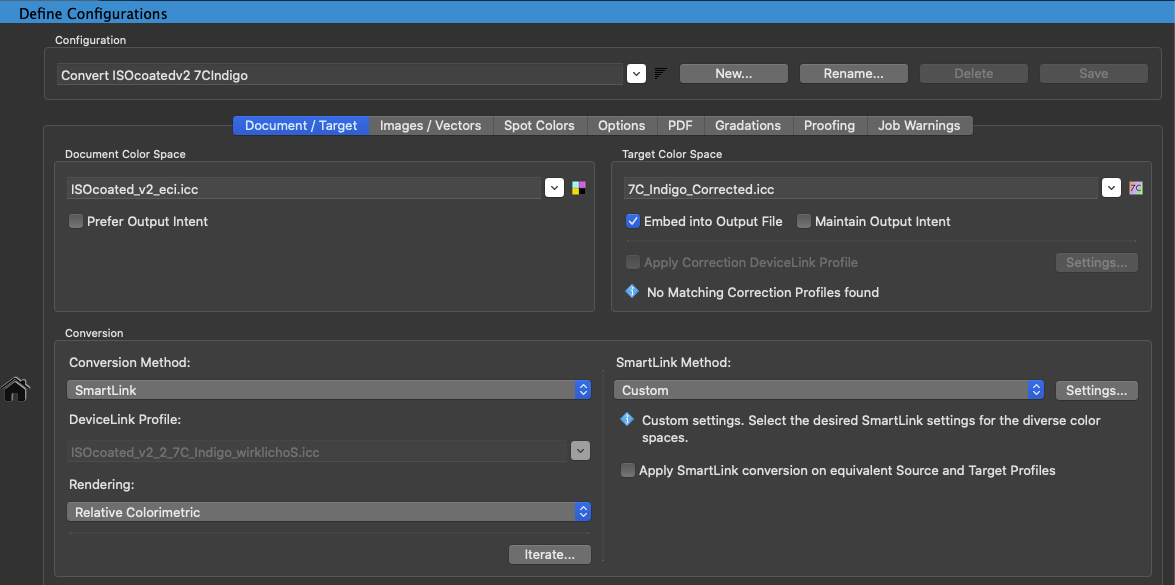
Document/Target
Document Color Space
The document color space acts as a reference to define a uniform color space for the colors of the PDF file.
- CMYK color spaces are usually used for print production, as CMYK colors are generally used for printing.
- RGB document color spaces are suitable for web, mobile or multimedia applications.
- Multicolor color spaces are often used in HiFi packaging printing, ECG (Extended Color Gamut) printing or in modern digital printing.
ZePrA supports the full spectrum of color spaces (Multicolor color spaces require a corresponding Multicolor license). If there are individual RGB or CMYK objects with embedded profiles in PDF files, these are converted to the document color space by default (except in Auto Setup mode Direct Color Conversion to the new Output Condition). If necessary, this can be changed in the Images/Vectors tab. For professional print productions, the data exchange is based on the PDF/X standard.
The document color space can be defined either by the output intent of the PDF/X file or by the ICC device profile that was (most likely) used when the document was created. If the file does not contain an output intent, select an ICC device profile under Document Color Space. The color space of the selected profile is displayed next to the drop-down menu.
Prefer Output Intent
In PDF/X documents, the document color space is defined by the output intent. By activating this checkbox, the output intent of the PDF/X file is used vs. manually setting the document color space.
For non-PDF/X documents, select (in addition to the ICC device profiles of the individual PDF file objects) an ICC device profile as the document color space that defines the color space of the entire PDF document.
If Prefer Output Intent is enabled, PDF/X files with several output intents can be correctly converted in a queue because the respective output intent is considered instead of the document color space. In this case, it is recommended to work with SmartLink instead of a fixed DeviceLink profile when converting from document to target color space.
Notes:
- This function is only suitable for PDF/X files.
- If you have reason to believe that the output intent of a PDF/X file has been set incorrectly, specify a suitable ICC profile as the Document Color Space and uncheck the Prefer Output Intent checkbox.
- The Prefer Output Intent option should not be used together with the Conversion Method “DeviceLink Profile” as it can produce undesirable results when the output intent profile of a PDF is not identical with the source profile of the used DeviceLink profile.
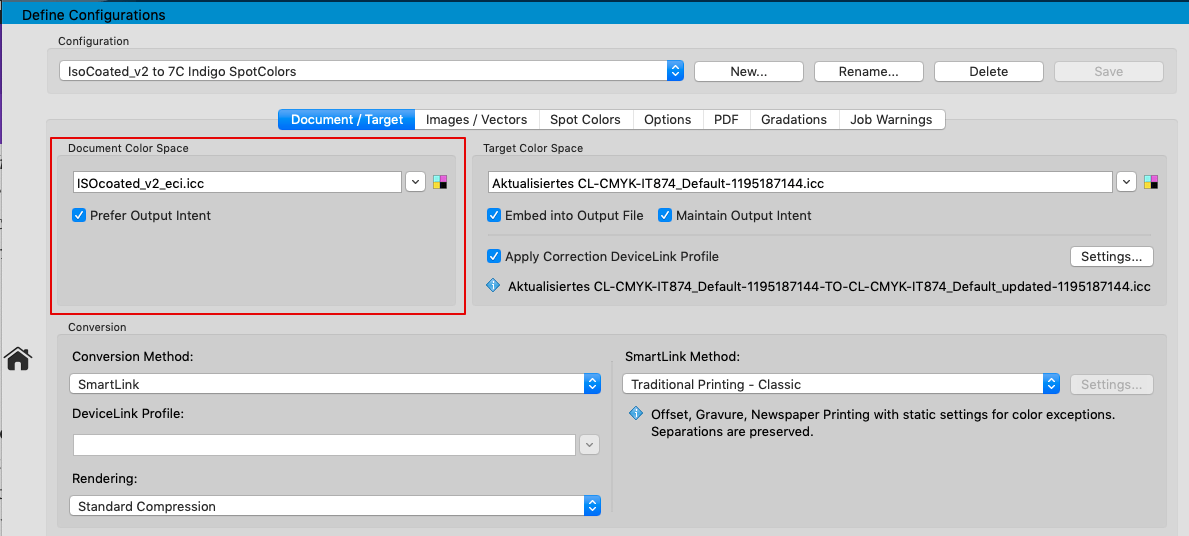
PDF 2.0 Support
PDF 2.0 files can have page level output intents. In regards to color conversion, the means different pages can contain different output intents. The checkbox Prefer Output Intent in the Document/Target tab must be enabled to consider this type of output conditions for the conversion. If the checkbox is enabled all objects on each page will be converted to the Target Color Space with the settings defined under the Image/Vector and Document/Target tabs using the corresponding output intent of each page.
Disabling the checkbox ignores the page level output intents and the conversion is done for all pages using the same source ICC profile defined as Document Color Space.
Another major feature of PDF 2.0 files is the support of black point compensation in combination with the relative colorimetric rendering intent.
Target Color Space
Under Target Color Space, select the target ICC profile. If the document color space/output intent of a PDF/X file does not match the color space of the final printing process, the entire PDF file needs to be converted from the Document Color Space to the Target Color Space. For the best quality of the conversion DeviceLink profiles or SmartLink can be used.
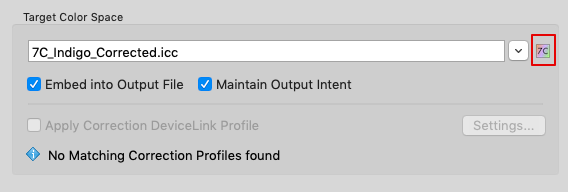
In addition to the selected target profile, the color space of the target profile is also shown, which is especially useful for Multicolor profiles with 5, 6 or 7 channels.

Moving the mouse over the color space icon displays the channel names of the Multicolor target profile.
If CoPrA profiles with viewing conditions other than the standard are selected in the Configuration (e.g., D65 and 10 degrees, as typically used in textile printing), this is indicated by a light bulb icon next to the profile drop-down menu.

When hovering the mouse pointer over it, the Viewing Condition (e.g., D65, 10 degrees) is displayed and set automatically in the CIE Conversion.
Note: The light bulb icon only appears for non-standard viewing conditions. The viewing condition can be changed manually under Viewing Condition/CIE Conversion in the Options tab. However, this could have undesirable consequences and cause a workflow warning.
Setting the Target Color Space
The Target Color Space is defined by the target profile selected in the drop-down menu. If the configuration was created with Auto Setup, the selection is automatically made by selecting the target profile or a DeviceLink. If required, the target profile can be changed here.
Embed into Output File: Embeds the target profile into the file after conversion.
Maintain Output Intent: The output intent of the file is used as the target profile instead of the selected target profile. The colors are converted to the output intent instead of the selected target profile.
This function should only be used if no changes to the output intent are necessary, or when simply normalizing a PDF/X file.
Usually, it is not intended to leave the output intent unchanged during color conversion. However, if this is required, set the Output Intent PDF/X in the PDF tab to Don’t change.
Notes: If the file has no output intent, this option has no effect.
Embedded profiles in image files (TIFF, PSD, JPEG) are not regarded as output intent. Therefore, this function has no effect on image files.
Minimize Output Channels: Reduces the number of channels to the bare minimum required to process the job without compromising the quality significantly.
If a Multicolor target profile is used and spot colors are to be converted, it is often not necessary to use all Multicolor channels. Depending on the spot colors used, 4, 5 or 6 channels can be sufficient for a given job. Having fewer channels in digital printing saves click costs and inks, and in traditional printing it saves plates and inks as well.
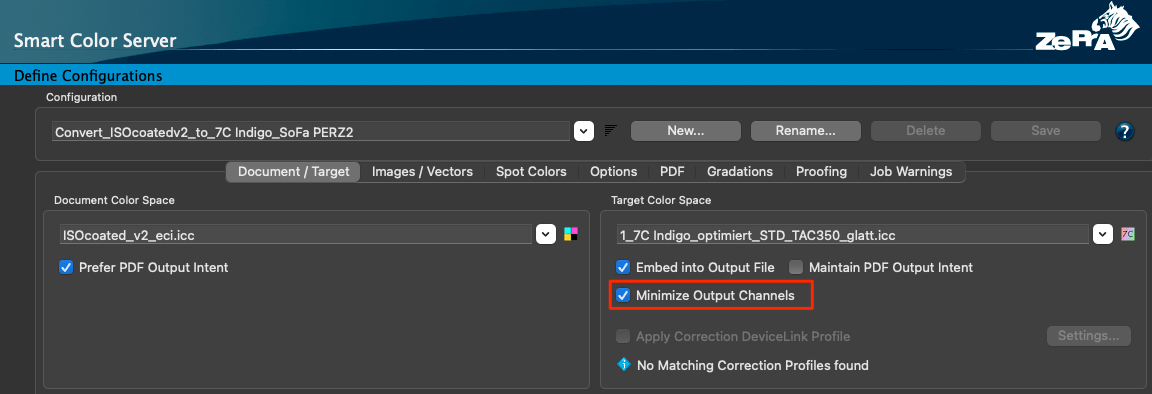
To reduce the number of channels, ZePrA calculates and creates several variants of the original Multicolor target profile that use fewer channels. For example, based on a 7C target profile, ZePrA creates a CMYK profile, three 5C profile variants, and three 6C profile variants – this can take some time. All these eight profiles are automatically analyzed to determine the best profile, which is then used for the conversion of the job – this check is done quickly. The beauty of this feature is that when processing multiple jobs with different spot colors, different profile variants can automatically be used in the same configuration.
Notes:
- If the profile variants for the given target profile have already been created by CoPrA, ZePrA can use those existing ICC profiles and does not need to recreate them, which speeds up processing.
- The option is available only when a Multicolor target profile is selected, and it generates the most benefit when the spot color conversion is enabled (in the Spot Colors tab).
- If jobs without spot colors are to be converted, the file will be converted to CMYK, as this results in the minimum number of channels with still acceptable quality.
- The Minimize Output Channels option is available for the SmartLink and Device Profile Conversion Methods. It is grayed out in case the conversion is done with a specific DeviceLink Profile or if No Conversion is to be performed.
- The Minimize Output Channels option is also grayed out when the Maintain PDF Output Intent checkbox is on.
- If a specific spot color rule has been set up in the Spot Colors tab, a workflow warning is displayed. In such cases, the Minimize Output Channels option cannot override the spot color rules and may not work as intended.
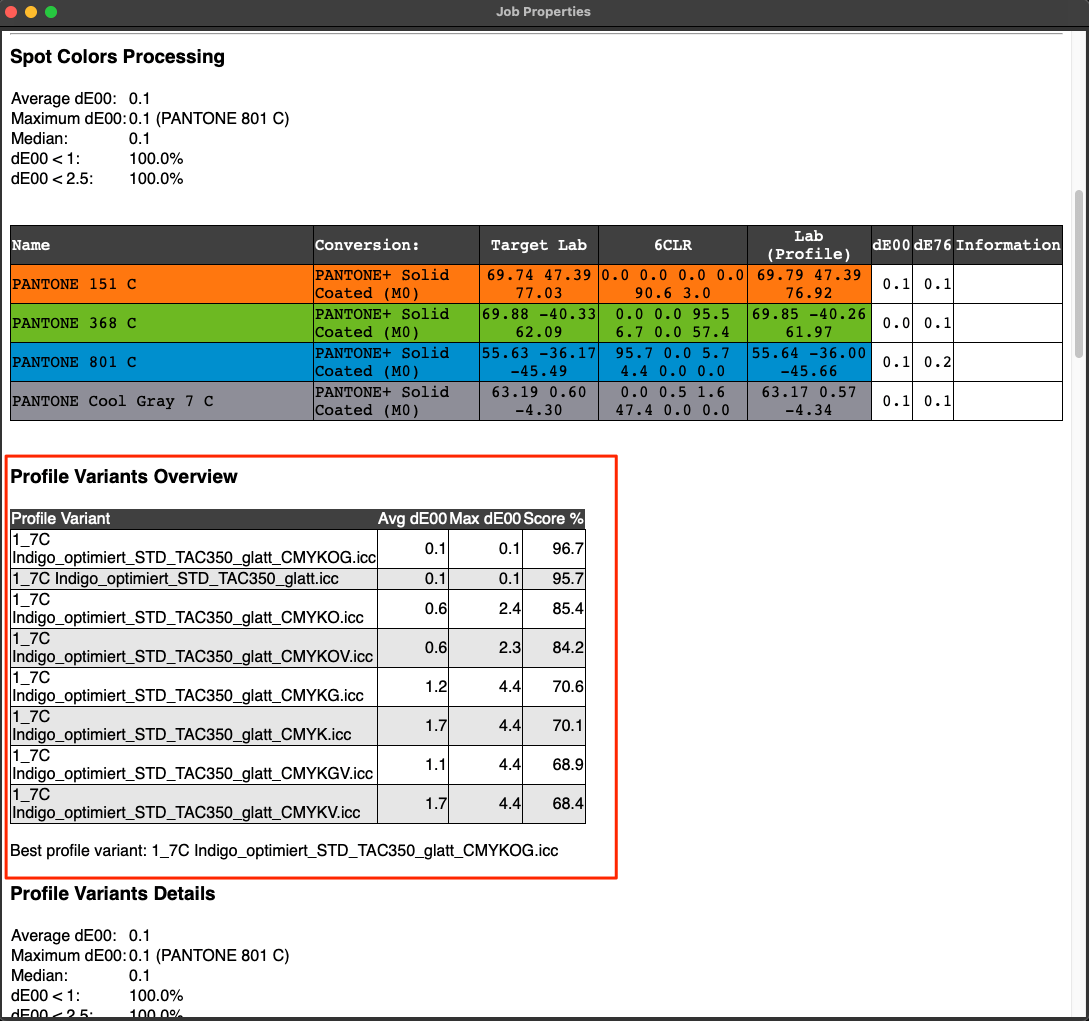
All calculated Profile Variants are also included in the Job Properties Report, which is available in the context menu that appears after right-clicking on the job in the list of Processed Jobs. The report shows the results for spot colors converted with all the profile variants, alongside the profile that is actually used for the job indicated as the target profile. This is helpful to understand why the automatically selected Best profile variant has been used by ZePrA.
Note: The evaluation ZePrA uses to determine the best profile is the same as in the Spot Color Report to determine the best configuration. It considers the average and maximum deltaE2000, as well as the number of channels, and is explained in more detail here: Spot Color Report
Apply Correction DeviceLink Profile
Variations in printing due to new paper batches, different tone value increases, or changes in inks can be compensated for with updated profiles and Correction DeviceLinks.
Apply Correction DeviceLink Profile: This checkbox becomes available when a Correction DeviceLink profile for the target color space exists.
- Create a Correction DeviceLink profile with CoPrA.
- In ZePrA, activate the Apply Correction DeviceLink Profile checkbox under Configurations in the Document/Target tab.
- Click Settings and select the Correction DeviceLink profile.
- Embed the updated Target Profile instead of the Target Profile: Embeds the corresponding optimized target profile into the converted file. This profile then becomes the new output intent of the converted PDF file. The corrected target profile is displayed.
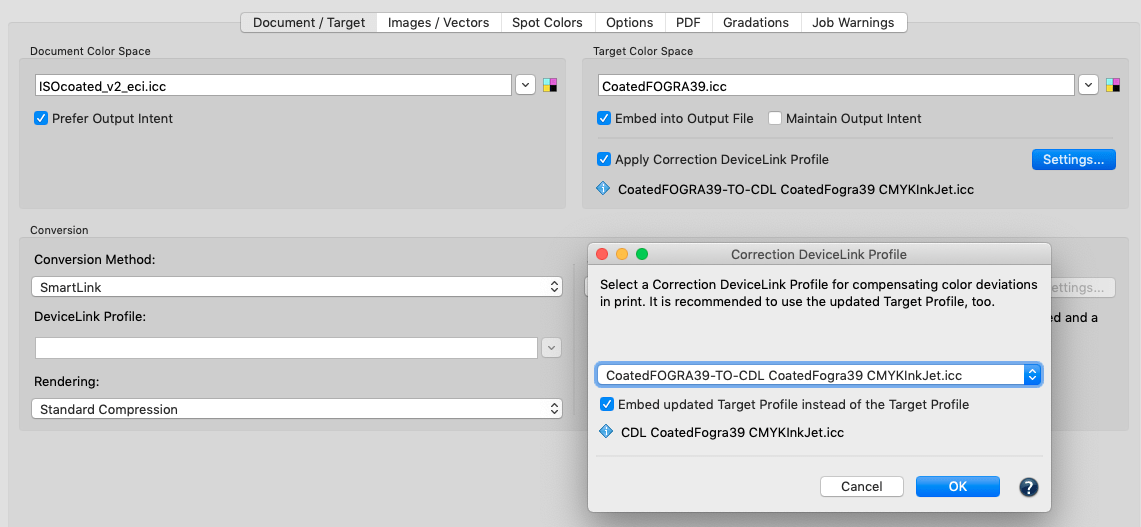
Note: ZePrA checks whether suitable Correction DeviceLink profiles and optimized printer profiles exist for the selected Target Color Space. Only corrected or optimized profiles are shown and can be selected after activating the Apply Correction DeviceLink Profile checkbox. If there are no Correction DeviceLink profiles, the checkbox is grayed out.
Conversion
Conversion Method
There are four conversion methods:
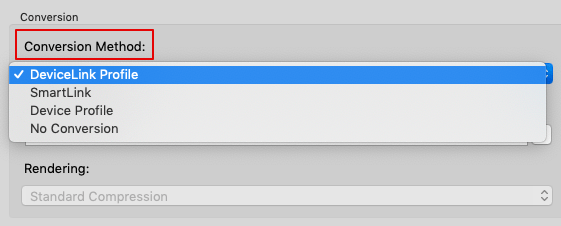
- DeviceLink Profile
Conversion of the complete PDF document via a DeviceLink profile
A DeviceLink profile represents a tailor-made color conversion from a defined source to a target profile. Within the ICC standard, a PSID tag can be used in the DeviceLink profile to store information regarding the source and target color spaces of the DeviceLink profile. If a DeviceLink profile has been selected, ZePrA can read its PSID tag and automatically define the profiles under Document Color Space and Target Color Space.
Note: All ColorLogic DeviceLink Sets from profile version CoLoV3 and higher contain PSID tags.
- SmartLink
- Select SmartLink as Conversion Method (only available if licensed)
- Select the SmartLink Method to be used for on-the-fly calculation of DeviceLink profiles from the Document Color Space to the Target Color Space.
- Select the appropriate Rendering intent
- Device Profile
Conversion of the PDF document with an ICC device profile
Converts the PDF document from the Document Color Space to the Target Color Space using the ICC device profile set under Target Color Space. Select the corresponding Rendering intent.
- No Conversion
The document is not converted to the Target Color Space. Other color conversions defined under Images/Vectors or Gradations or Spot Colors still take place.
Example: A basic print-ready PDF (which does not need to be converted) still contains spot colors that must be converted to process colors.
Rendering
General information on the design of ICC device profiles
Rendering intents, such as Perceptual or Relative Colorimetric with CMYK profiles, contain large tables which convert either CMYK color values to Lab or Lab color values to CMYK.
Due to the nature of ICC Profiles that can be used in two directions, there are two tables for each rendering intent. The tables are calculated from the measurement data when a color profile is generated.
If ICC device profiles are calculated from the same measurement data – but with different profiling programs – then the tables generated can differ considerably in some color ranges.
This is especially true for the two tables of the Perceptual intent, for the gray balance and also for areas with very high color saturation in the two tables of the Relative Colorimetric intent (also called “Out of Gamut” colors).
For optimal and harmonious color conversion, it is recommended (especially with CMYK-to-CMYK color conversions) to ensure the source and target profiles were calculated with the same profiling software.
Profiles from different providers (such as Adobe, ECI, or ColorLogic) are often used in practice, which can lead to problems in color conversions based on the perceptive rendering intent.
These problems can be avoided by using SmartLink.
The SmartLink module uses the source profiles embedded in PDF or image data and automatically calculates the DeviceLink profile required for conversion between source and target for each object and applies it at the object level. The main conversion from the document color space to the target color space is also carried out via SmartLink. SmartLink is ideal for processing external data from a wide variety of sources to ensure optimum color accuracy (via DeviceLinks).
Additional SmartLink Rendering Intents
The SmartLink module provides several additional rendering intents to avoid problematic color conversions, which can result from tables calculated differently for source and target profiles.
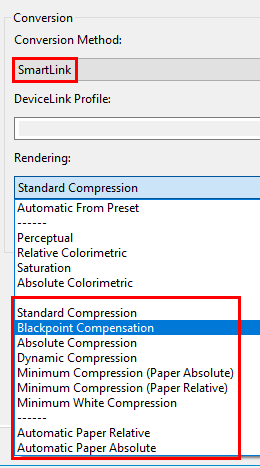
To ensure precise color conversions, ZePrA completely recalculates the conversion of source and target profiles on-the-fly. The algorithms are the same as in ColorLogic’s CoPrA profiling software.
Note: These additional rendering intents are only available with SmartLink enabled. If the checkbox Use SmartLink is not activated or SmartLink has not been licensed, only the four standard rendering intents will be available.
Automatic from Preset: This option is for Custom SmartLink Methods shared from CoPrA and takes whatever setting has been selected in the shared DeviceLink setting from CoPrA, including the rendering options, like a merge between two rendering options, chroma or saturation boosts, all exceptions and black generation settings.
Note: Automatic from Preset is only available in the drop-down menu when a custom SmartLink Method is selected. So, first select a custom SmartLink Method and the option Automatic from Preset will be on top of the list.
Note: In earlier versions of ZePrA (9 and lower) it is not possible to merge two different rendering options for color conversion, because the rendering settings of a profiling setting shared from CoPrA are always overwritten by the rendering setting selected in ZePrA.
Standard Compression: This is the default method. It uses a perceptual conversion that is well suited for all types of gamuts, i.e., also for conversions between color spaces of different sizes. Neutral tones are converted using a relative colorimetric approach, and the appearance of the gray axis always depends on the paper white of the target profile. Therefore, the gray axis of the transformed file will appear yellowish on a very yellowish paper. The same gray axis will appear bluish on a bluish paper. For very small color gamuts, for example in newspaper printing, the dark tones are raised slightly to achieve more image definition in these areas.
Blackpoint Compensation: Use Blackpoint Compensation to achieve the same results with a perceptive conversion as with “Relative Colorimetric with Black Point Compensation”. When converting from large to small color spaces, the image definition is preserved in the highlights and shadows, unlike with a pure Relative Colorimetric conversion. Neutral tones are converted using the Relative Colorimetric intent. Out-of-gamut colors are cut off.
Absolute Compression: This method is based on the absolute colorimetric rendering intent in terms of color reproduction and is recommended when the paper tones differ significantly (the color gamuts can be similar or different). In contrast to the Standard Compression and Blackpoint Compensation, the paper tint is compensated in the gray balance. The rendering of neutral colors is based on the absolute colorimetric rendering intent, without paper tone simulation in the highlights. If, for example, the paper white is significantly more yellow than in the reference, the gray axis appears neutral despite the yellowish paper tone. This ensures that the color appearance of the original file is preserved as best as possible on a target medium with a different paper tint. The contrast range in the highlights and shadows is adapted to avoid any loss of image definition.
Minimum Compression (Paper Absolute): This method is largely similar to the absolute colorimetric intent and only compensates close to the black and the white point.
In addition, the white point of the source color space is not simulated, but scaled to the white point of the target color space, thus ensuring a pure paper white.
Use this rendering intent to achieve a close reproduction, for example when using print standards such as ISO Coated V2 or GRACoL2006 Coated1v2 on a digital printer.
Note: As for the absolute colorimetric rendering intent, ensure that the target color space is larger or has at least a similar size to avoid any loss of image definition. For color conversions from larger to smaller color spaces use Absolute Compression to maintain the gray balance of the source color space.
Minimum Compression (Paper Relative): This method is largely similar to the relative colorimetric intent and only compensates close to the black and the white point. It is similar to Minimal Compression (Paper Absolute) but uses relative colorimetric instead.
Dynamic Compression: Compares the source color space with the target color space and generates a compression that minimizes out-of-gamut areas. This setting preserves the brightness of the original color space while reducing the saturation, and therefore also preserves the image definition. As for the Standard Compression, the gray axis of the conversion is built relative to the paper white of the target profile. This approach is well suited when the source and target profiles have a very large dynamic range and contrast, for example, in RGB-to-CMYK conversions.
Note: This method is now only available in ZePrA for compatibility reasons, and no longer in CoPrA. We recommend using Automatic Paper Relative instead.
Minimum White Compression: This method is similar to Minimum Compression (Paper Absolute). Both rendering intents compress the white point without paper simulation, however, there is an important difference: The Minimum Compression is a rather perceptual rendering that additionally compresses the black point, so the maximum dynamic range is utilized without loss of detail in the shadows. In contrast, the Minimum White Compression compresses the white point but not the black point, so a close absolute colorimetric match between source and target color spaces can be achieved. This can be useful for the color representation across various media, color matching or printing on slightly differing media. It can be regarded as close to absolute colorimetric rendering without paper tint simulation.
Note: Remember that the target color space should be larger than the simulated color space (or similarly large) to avoid loss of detail and vividness (similar to the absolute colorimetric rendering intent). For conversions from large to small color spaces, instead use our rendering intent Absolute Compression if the gray balance of the source color space is to be preserved.
Automatic Paper Relative: A paper relative rendering without consideration of the paper tone. Leaves the gray balance with the paper tint as is. A typical use case would be a rather more colorful but still faithful rendering of a color space on a different printer. For example, a campaign prepared for ISO coated V2 but rendered on a large format inkjet printer without consideration of the paper tone.
Automatic Paper Absolute: A paper absolute rendering with consideration of the paper tone. For a gray balance that compensates the paper tint. A typical use case would be the same as for Automatic Paper Relative, but with consideration of the paper tone.
Important: For PDF processing ZePrA typically uses the rendering intent defined in the PDF for each object. When deviating from this rule, ensure that an on-the-fly DeviceLink profile created with SmartLink uses the rendering intent set under Configurations > Images/Vectors, select the checkbox Ignore PDF Rendering Intents in the Options tab.

SmartLink Method
The SmartLink function uses the ICC device profiles set in ZePrA, or embedded in images and PDF files, to create DeviceLink profiles on-the-fly. Supported color space combinations include:
Supported color spaces for Document and Target Color Space are:
Gray, 1 channel to 3 channels including CMY (Multicolor 1-3), RGB, CMYK, 4 channels to 15 channels (Multicolor 4-n)

Note: CMY profiles are supported as Document Color Space (from ZePrA 12 and higher) which offers some possibilities for workflows that use CMY channels exclusively, such as proofing digital printing devices that use CMY to increase production speed and save clicks, or workflows that convert between CMY printers to balance workloads.
Predefined SmartLink Methods (Presets)
The SmartLink Method considers the specific requirements of different printing conditions, so that the printed color is correctly reproduced and optimally separated for the printing process.
Note: The SmartLink Method drop-down menu provides presets for Multicolor if the checkbox Prefer Output Intent is enabled. This allows for automatic processing of PDF/X-5n or PDF/X-6n files with Multicolor output intent.
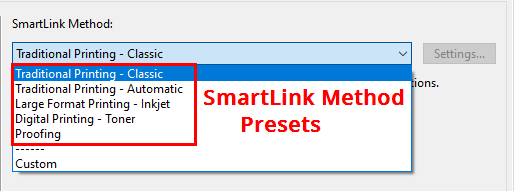
Traditional Printing – Classic: Conversions for offset, gravure, or newspaper printing. The DeviceLinks created ensure that black and gray, as well as the primary, secondary and triplex hues of the source profile, are preserved. The total area coverage is taken from the target profile.
Traditional Printing – Automatic: Select this setting when the colors and paper of the target color space are significantly different from the output intent or document color space. Separation is preserved, but Exceptions for special colors such as black and gray, primary, secondary, and triplex colors are automatically calculated based on both profiles.
Large Format Printing – Inkjet: The separation settings and the total area coverage are taken from the selected target profile. The Exceptions for special colors, such as black and gray, primary, secondary, and triplex hues, are automatically calculated based on both profiles. This is to avoid problems that can occur when the hues of the primary inks vary between different inkjet printers or between the inkjet printer and the source color space (as with ISOcoated V2 or GRACol).
Digital Printing – Toner: For toner-based digital printers and office printers. The separation method ensures a high percentage of black and an early black start. This will achieve a stable print and neutral gray balance. The total area coverage is taken from the target profile. The Exceptions for special colors, such as black and gray, primary, secondary, and triplex hues, are automatically calculated based on both profiles.
Proofing: For proofing applications. All exceptions are disabled. All separation settings of the target profile are applied. The rendering intent should be set to Absolute Colorimetric. When using the Proofing method in the Auto Setup Wizard, the rendering intent is automatically set to Absolute Colorimetric.
Note: All methods that automatically calculate Exceptions can result in grey, primaries, and secondaries being built with multiple colors, which can lead to overprinting problems in complex PDF files. If SmartLink has not been licensed, the Auto Setup Wizard creates configurations differently to avoid overprinting problems. Without a SmartLink license, CMYK objects with embedded profiles are treated like objects without profiles and are converted with the selected DeviceLink profile.
In general, if a predefined SmartLink Method (one of the Presets) has been selected, no further SmartLink settings need to be changed.
Note: In contrast to using a predefined SmartLink Method, when using Custom as a SmartLink Method SmartLink settings must be reviewed and adjusted if necessary!
TAC Reduction: Reduces the total amount of ink applied while maintaining color perception. This method is only available if the CMYK profiles for the Document Color Space and the Target Color Space are identical.
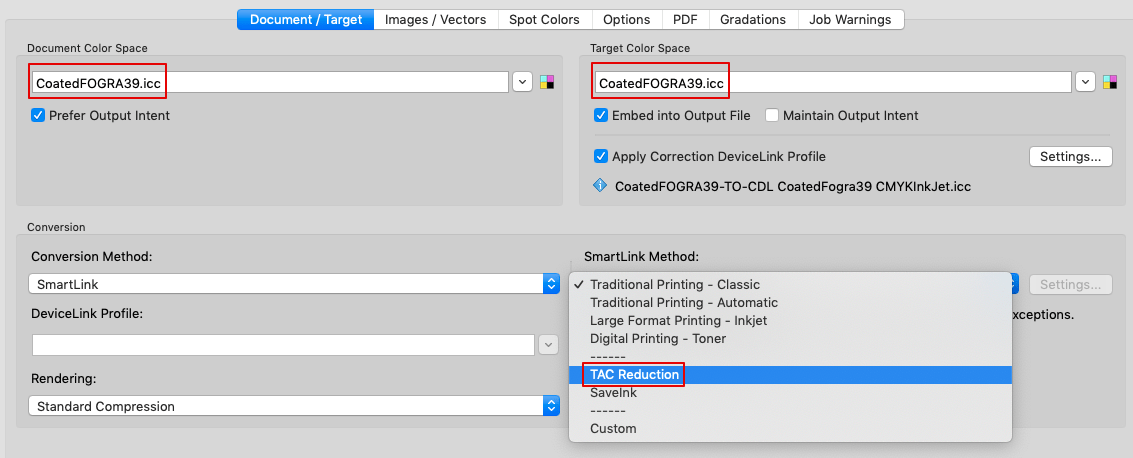
The required maximum ink application can then be specified in percent under Settings. By default, the TAC settings are read from the profile of the Target Color Space.

SaveInk: Reduces overall ink application while maintaining color perception. This method is only available if the CMYK profiles for the Document Color Space and the Target Color Space are identical. Predefined methods can be selected under Settings. With Import, you can also import your customized settings created (and exported) with CoPrA. SaveInk requires ZePrA XL or higher, or a SaveInk and SmartLink license.
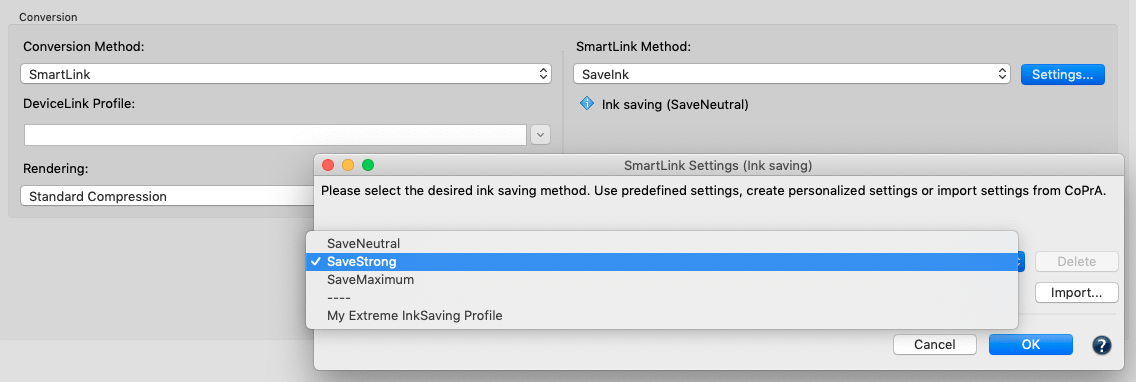
SaveNeutral: Moderately increases the amount of black in neutral color areas. Ideal for print shops looking for a quick introduction to saving ink and wanting to gain practical experience. These profiles primarily stabilize the printing process and are less suitable for saving large quantities of ink.
SaveStrong: The black portion is significantly increased. This is aimed at print shops that have control of their printing process in accordance with standardization and are looking for high ink savings, but still want to leave room for adjustments on the press.
SaveMaximum: Maximizes the amount of black and provides the greatest ink savings. Mainly suitable for print shops that have successfully implemented standards and control them completely.
Apply SmartLink conversion on equivalent Source and Target Profiles: By default, ZePrA skips conversions of source and target color spaces with identical profiles to avoid unnecessary color changes. Enabling the checkbox ensures conversion between Image and Vector color spaces to the Target Color Space or between Document and Target Color Spaces with equivalent profiles using the selected SmartLink Method.
Note: ZePrA contains an internal list of almost all known standard profiles. Many of these standard profiles are available in several variants which are also included in the list. These variants are the equivalent profiles recognized by ZePrA.
Equivalent profiles are for example: ISOcoated V2.icc, ISO coated V2 (300).icc, CoatedFOGRA39.icc, ISOcoated V2 (bas).icc
This option does not apply to conversions from Image/Vector to the Document Color Space.

Using CoPrA’s DeviceLink Settings in ZePrA
Due to the close connection between CoPrA (ColorLogic’s profiling solution) and our color server ZePrA, the profile settings from CoPrA can be used to calculate DeviceLink profiles in ZePrA.
Detailed information on how to share CoPrA’s DeviceLink settings with ZePrA can be found under Share with ZePrA.
Custom SmartLink Settings
Custom SmartLink Settings
When Custom has been selected as SmartLink Method, the Settings button is enabled allowing customization of the conversion between color spaces.
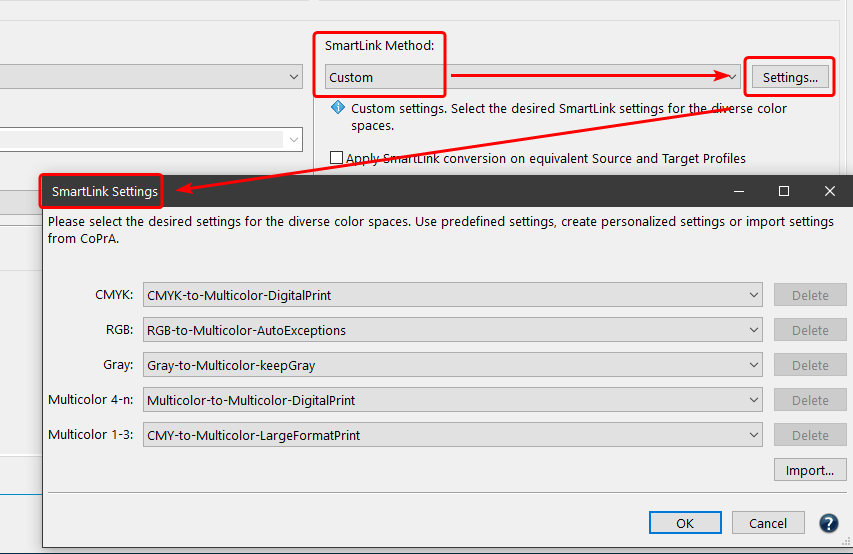
Settings: In the SmartLink Settings window, specify how to convert between color spaces. This includes the conversion from the Document Color Space to the Target Color Space as well as from the color spaces in the Images/Vectors tab either to the Document Color Space or to the Target Color Space.
For all color space conversions, presets or custom settings (created by CoPrA) can be selected. Import can also be used to import custom settings created (and exported) by CoPrA.
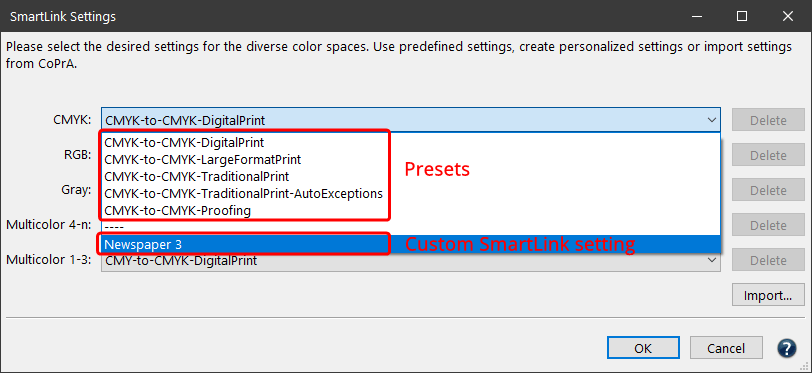
Note: Use Custom SmartLink Settings with caution, as they are only appropriate for the color space combination for which they are intended. When using a Custom SmartLink Setting, the color spaces are not automatically adjusted. Therefore, a CMYK-to-CMYK preset will not work for a target profile that has been changed to RGB or Multicolor and will result in warning or error messages.
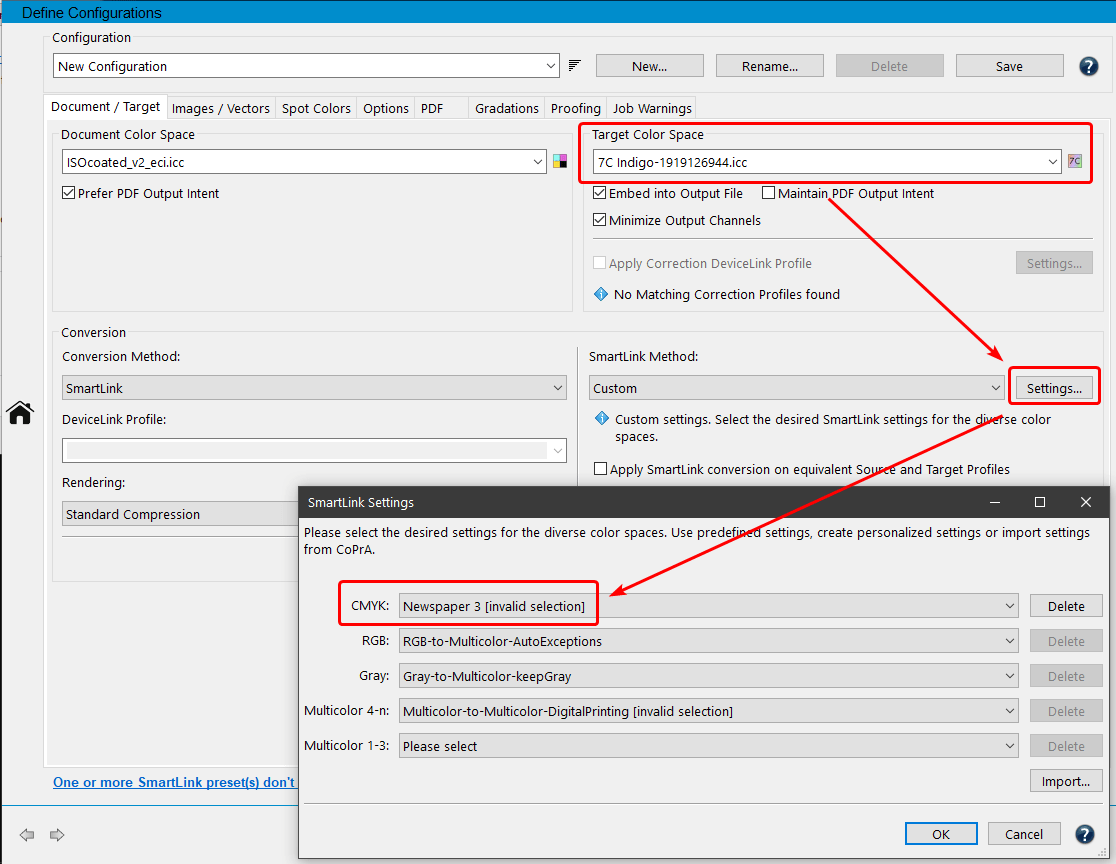
In contrast to using a predefined SmartLink Method, when using Custom as a SmartLink Method, SmartLink settings must be reviewed and adjusted if profiles and color spaces for Document and/or Target Color Space are changed!
Multicolor 1-3: Provides SmartLink presets that cover 1CLR to 3CLR profiles, including CMY, which can be selected as Document Color Space. Enables the use of 1CLR to 3CLR SmartLink presets independently of other Multicolor SmartLink presets.
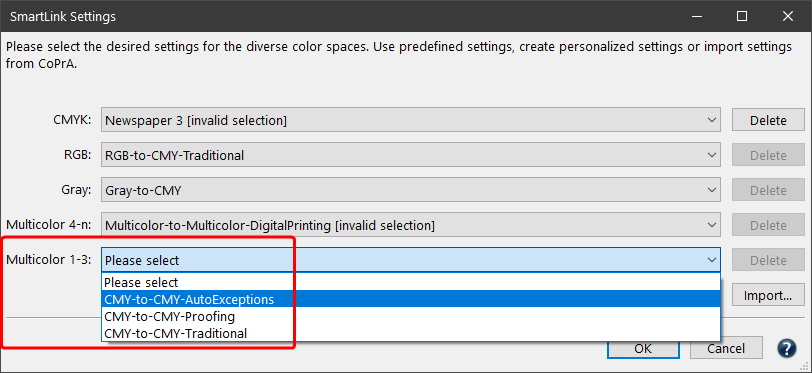
Note: The Multicolor SmartLink option is intended for source profiles with 4 or more channels (except CMYK). The Multicolor 1-3 option covers source profiles with 1 to 3 channels, including CMY.
Apply SmartLink conversion on equivalent Source and Target Profiles: By default, ZePrA skips conversions of source and target color spaces with identical profiles to avoid unnecessary color changes. Enabling the checkbox ensures conversion between Image and Vector color spaces to the Target Color Space or between Document and Target Color Spaces with equivalent profiles using the selected SmartLink Method.
Note: ZePrA contains an internal list of almost all known standard profiles. Many of these standard profiles are available in several variants which are also included in the list. These variants are the equivalent profiles recognized by ZePrA.
Equivalent profiles are for example: ISOcoated V2.icc, ISO coated V2 (300).icc, CoatedFOGRA39.icc, ISOcoated V2 (bas).icc
This option does not apply to conversions from Image/Vector to the Document Color Space.

Using CoPrA’s DeviceLink Settings in ZePrA
Due to the close connection between CoPrA (ColorLogic’s profiling solution) and our color server ZePrA, the profile settings from CoPrA can be used to calculate DeviceLink profiles in ZePrA.
Detailed information on how to share CoPrA’s DeviceLink settings with ZePrA can be found under Share with ZePrA.
DeviceLink Iteration
Overview
Iteration can be necessary to achieve the best possible color match, especially when proofing. To apply an iteration, a special test chart must be converted with the desired color management settings of a given configuration, printed and measured. Based on the measurements the DeviceLink profile can then be optimized. After one to three iteration cycles, a closer match in terms of DeltaE values is achieved. This process is error-prone if done manually, however, it is easy to accomplish with the help of the DeviceLink Iteration Wizard, which guides you through each step.
Video Tutorial
Overview of the DeviceLink Iteration Wizard in ZePrA.
Procedure
The iteration starts by selecting the configuration containing the DeviceLink to be iterated. This can be done in three different ways:
- In the Queues section of the Overview, select the queue and configuration you want to iterate. Open the context menu with a right click and select DeviceLink Iteration.
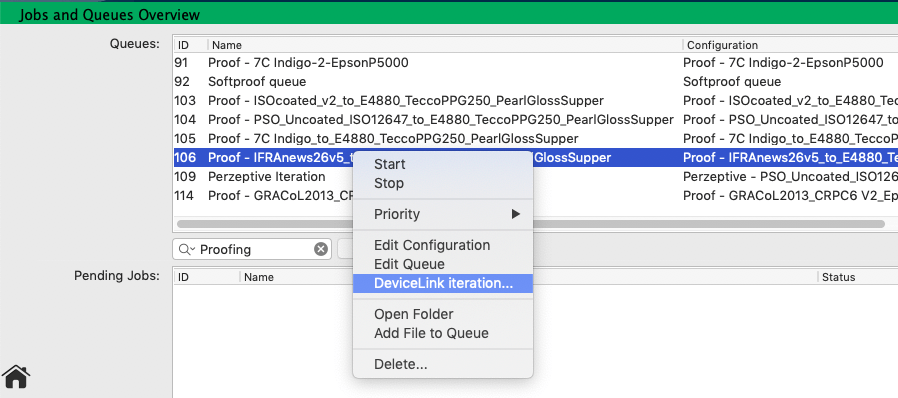
- Select DeviceLink Iteration from the Tools menu and search for the desired configuration in the Configuration drop-down menu of the appearing DeviceLink Iteration Wizard. You can use the same search and sort functions that you are familiar with from the Configuration drop-down menus elsewhere in ZePrA to find the configuration you are looking for.
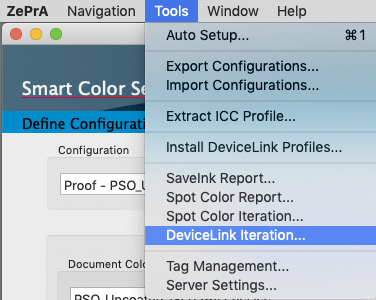
- Open the desired Configuration in the Document/Target tab and click on the Iterate button at the bottom of the Conversion section.

The DeviceLink Iteration Wizard dialog consists of two tabs, the Current Iteration and the Archive tabs. The Current Iteration tab contains the actual iteration wizard and typically, if a configuration is selected that has not yet been iterated, the wizard is started directly there. The Archive tab contains all the iteration steps that have been carried out, including all the evaluation details.
Current Iteration
The wizard guides the user through the iteration process in these four steps:
- Create test chart to be printed
- Print and measure test chart
- View Evaluation Results
- Continue or end the iteration
Step One: Create the test chart to be printed
There are two possibilities to create the test chart. Either you use the included Default Iteration Chart, which of course is always optimized for the color space of the given configuration. Or, select your own reference file (TXT, CXF3, XML) of a custom chart under Custom Iteration Chart.
After that, define your measurement Instrument Settings. Various settings for the supported measurement equipment can be selected from the drop-down menu in the Measure Tool (the Measure Tool is included in ZePrA).
Note: ColorLogic ColorAnt users can create their own instrument settings optimized for their specific requirements in the Export Chart tool.
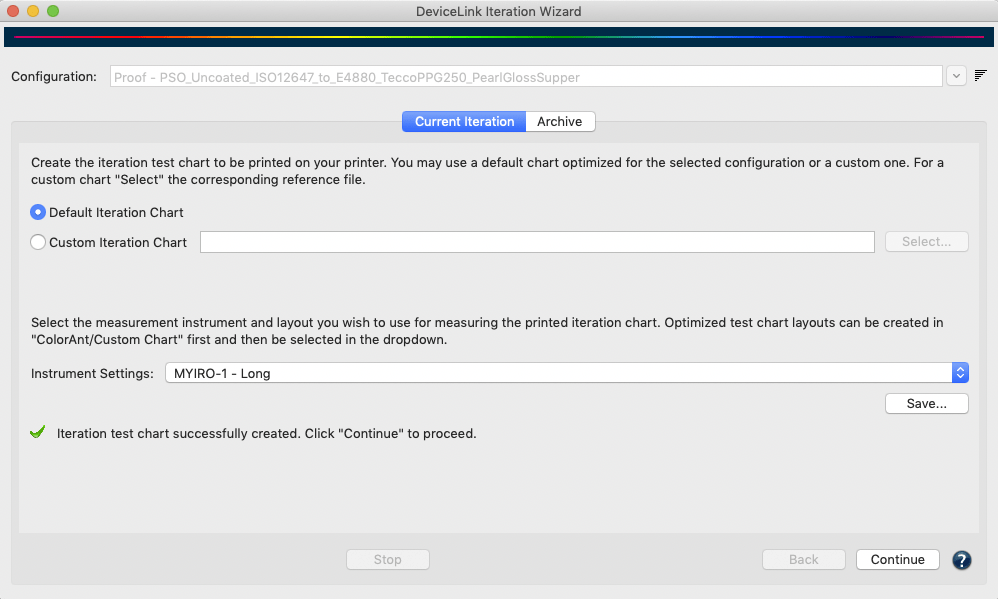
Click Save and choose a file format (PDF, TIFF or PSD) to create the test chart in the selected location. All color management settings of the configuration will be applied automatically.
Note: In some cases the creation of the chart may take some time, for example if the Conversion settings SmartLink or Device Profile are used in the configuration, as the wizard will then need to create a DeviceLink profile first.
After you successfully created the chart and the associated reference file, a message and a green check mark indicate that you can now proceed to the next step by clicking the Continue button.
Step Two: Print and measure test chart
The second step consists of two operations. First, the chart created in step 1 must be printed on the printer without color management settings. Then, after drying, the print must be measured. If the Measure Tool is to be used, simply click on the Measure button. You do not need to worry about the reference file and layout, as this is already preselected within the Measure Tool. Instructions on how to select your device and make measurements using the Measure Tool can be found here.
Note: Alternatively, you can use the previously exported reference file and measure your printed chart with a different measurement tool. Make sure that the measurements are saved in standard file formats that can be read by ZePrA, such as CGATS TXT, XML or CXF3. The external measurement files can be loaded using the Load button.
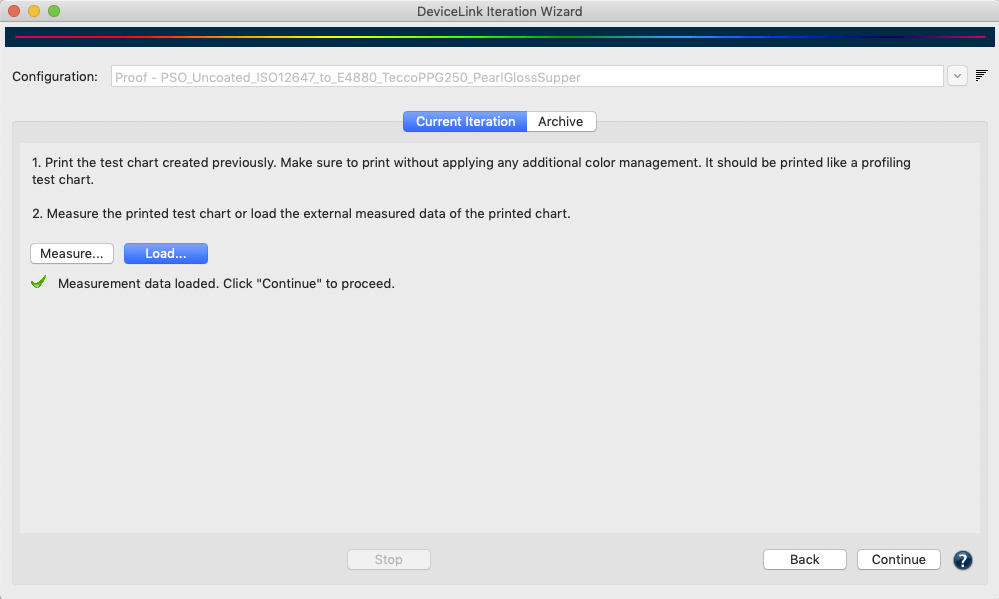
Once the measurement data has been transmitted from Measure Tool or loaded from external sources and it conforms to the printed chart a green check mark indicates a match and you can proceed by clicking Continue.
Note: When loading measurement data that does not match the chart layout or the corresponding patches in the reference file, you are alerted by a warning message and proceeding to the next step is not possible.
Step Three: View Evaluation Results
The third step shows the Evaluation Results of the measurements compared to the desired color conversion.
If all categories such as substrate, the maximum and average deltaE for all patches, etc. are within their limits they are marked green and the overall result is marked all right.
In a proofing case, e.g if an absolute colorimetric rendering intent was used in the configuration, the proof print is compatible with a Contract Proof according to ISO12647-7 and the wizard indicates this by a green check mark and a corresponding note text. A further iteration is then not required, hence the Don’t apply Optimization radio button is preselected.
However, the preselection can be overridden and another iteration cycle applied if the results are to be improved even further. To do this, select the Optimize DeviceLink and apply radio button and click Continue. Alternatively, apply the iteration later via the Archive tab.
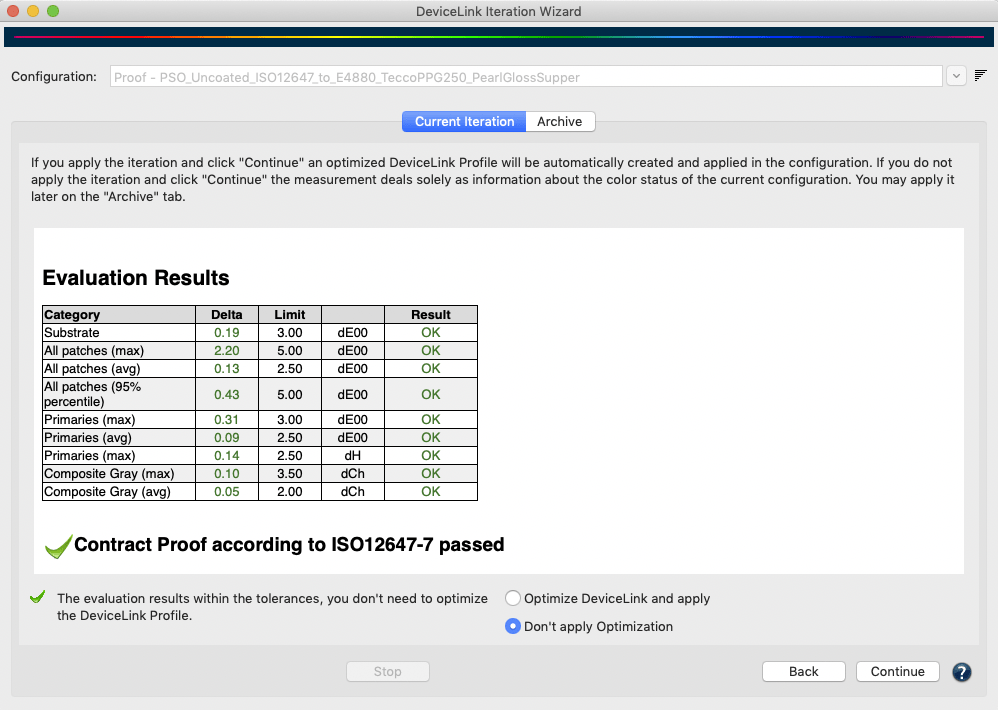
If only a single category is displayed in orange or red in the table of Evaluation Results, the proof print is considered to be not okay and the validation has failed. In this case, a warning is displayed and it is suggested to apply an iteration to improve the result. The corresponding radio button Optimize DeviceLink and apply is then preselected.
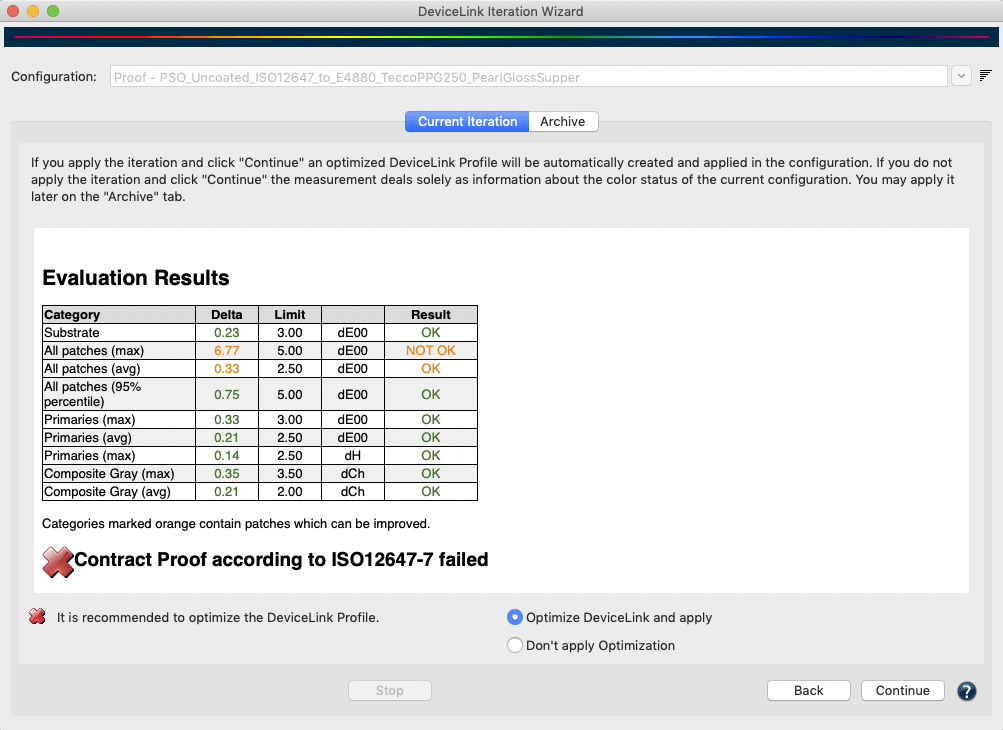
By selecting Optimize DeviceLink and apply and clicking on Continue, an iterated DeviceLink is created on-the-fly and automatically entered in the configuration.
ZePrA checks for out-of-gamut colors and evaluates whether those colors can be improved. Color values that are displayed in red in the Evaluation Results and Report are considered to be out-of-gamut and their deltaE00 values can most likely not be improved. Nevertheless, an iteration can slightly change the rendering of out-of-gamut colors, for example, to correct hue errors when colors are far from the desired hue. Color values that are displayed in orange, however, can be improved with further iteration. If there are only red values left, ZePrA informs, that further iterations are of no use and preselects the Don’t apply Optimization radio button. If, however, there are orange values left, these can be further optimized and ZePrA suggests Optimize DeviceLink and apply.
Step Four: Continue or end the iteration
The fourth step concludes the iteration cycle. Here, there are three options to choose from. Based on the previous results, the wizard already preselects a logical option for you to follow:
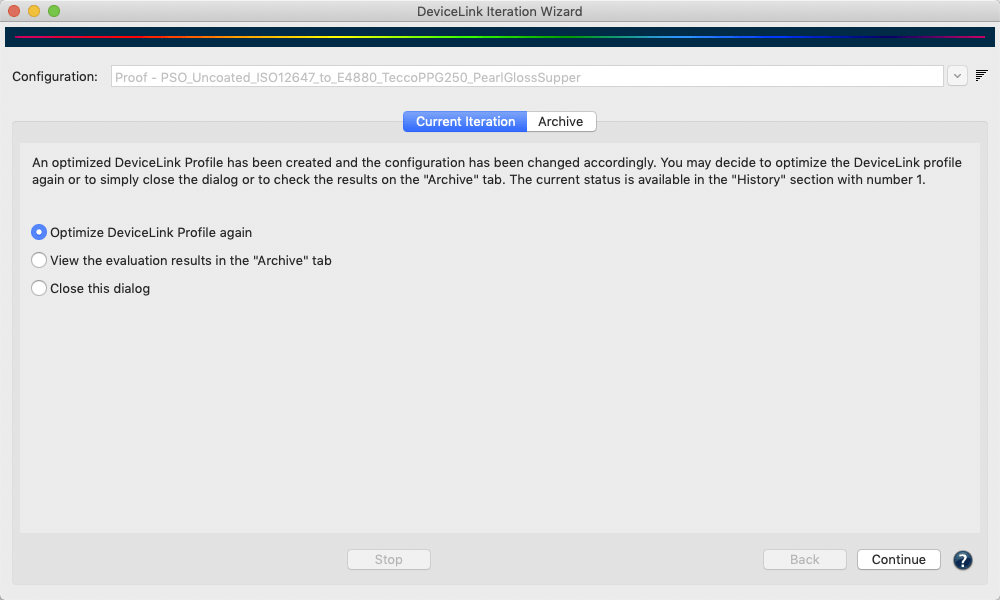
- Optimize DeviceLink Profile again: Runs another iteration cycle, for example to check whether a previously iterated DeviceLink successfully passes the evaluation. If you select this radio button and click Continue, a new iteration cycle starts with step 1 and the creation of a new test chart to be printed.
- View the evaluation results in the Archive tab: If you have already completed several iterations or would like to see the evaluation results once more, select this option. When you click Continue, the Archive tab opens with the last iteration step highlighted.
- Close this dialog: If the evaluation results are all right or if you want to end the iteration process you can simply select Close this dialog and by clicking Continue the iteration is ended.
Archive
All data created during the iteration - such as test charts, reference data and measurement data, as well as the report - are stored in an internal database in addition to the save location defined by the user.
Therefore, if data is deleted from the save location it can still be restored from the internal database any time via the Archive tab. Users can stop an iteration process and even close the DeviceLink Iteration Wizard dialog at any time and can revert back to the last completed step with the help of the Information stored in the Archive.
The Archive tab shows all iteration steps and evaluation details. The History table contains a list of all iterations, with the active iteration highlighted. More information for the selected iteration step is displayed under Details.
The columns of the History table show the iteration step number #, the maximum DeltaE00 value dE00 (max), the average DeltaE00 value dE00 (avg), the Status of the selected iteration step and some Information about the iteration process itself, such as Optimization applied, when the measurements done from the printed test chart have actually been used to create an iterated DeviceLink, or Evaluation measurement, when the measurements have been used for evaluation only and have not been used to create an iterated DeviceLink.
In addition, the iteration process (being performed in the Current Iteration tab) can be discontinued, which is indicated with various messages such as Next step: save chart, Next step: measure or load data, Next step: Evaluate.
Right clicking on an iteration step in the History displays a context menu with the following options:
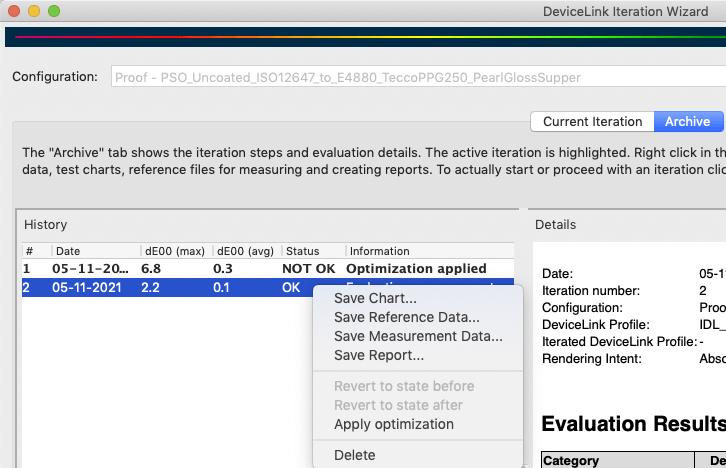
Save Chart: Exports the test chart into a file selected by the user. The test chart is not newly created but only copied from the internal database. This implies that the file selection only supports the file type initially chosen by the user.
Save Reference Data: Exports the reference data that belongs to the test chart into a file selected by the user.
Save Measurement Data: Exports the measurement data into a file selected by the user.
Save Report: Saves a report containing all Details displayed on the right and the full information about each measurement patch. This is useful to identify colors with the highest or lowest deltaE values, or colors which are out of gamut. The report is explained in more detail below.
Revert to state before: This is only available for iterations with the status applied. Reverts back to the state before this iteration, giving the previous iteration, if any, the applied state. The status changes to evaluation measurement. All subsequent items are deleted.
Revert to state after: This is only available for iterations with the status applied. Proceeds to the state after this iteration step, making it the active iteration. The status of a next iteration, if available, would be evaluation measurement. All subsequent items after the next iteration are deleted.
Apply Optimization: This is only available for iterations with the status evaluation measurement. It can be used for evaluation measurements that have not been applied in the iteration process itself. Use this option if you want to apply an iteration later on.
Evaluation Results
The Evaluation Results shown under Details are always the evaluations of the previous step. This means, if an iteration has been applied in step 1, the evaluation results shown under Details for the selected step 1 are the values before the iteration has actually been applied. Therefore, in order to see the results of the first iteration a second step is necessary. The evaluation results shown for that second step are actually the iteration results of the first iteration step, and so on. This offers the possibility to use the results of an iteration itself for a second iteration. But again, another measurement step is needed to find out if this iteration actually improved the result.
Evaluation measurements for the different Categories are shown according to the proof evaluation tolerances defined in ISO 12647-7. They can even be regarded as proof evaluation when an absolute colorimetric rendering intent has been used in the configuration. The values shown in the table can assume three different colored states that are green, orange or red. Values shown in green are within the Limit and therefore all right. Orange values are outside the Limit but can be improved by iteration. Red values are outside the Limit and cannot be improved. This is mostly the case if a source color can’t be reproduced in the target color space because it is out-of-gamut. An overall statement of the accuracy of the rendering is given below the table. A green check mark indicates that the color conversion is within the limits, whereas a red cross indicates that it is not.
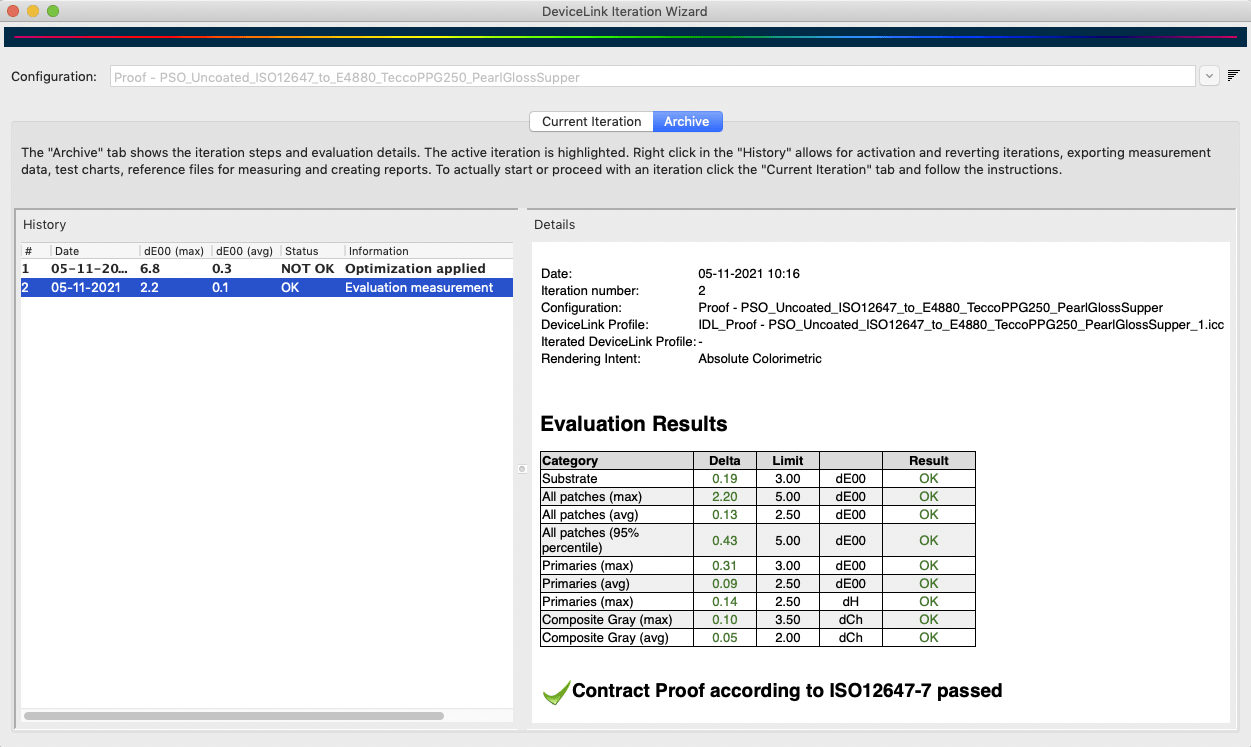
Special cases arise if the rendering intent used in the configuration is not absolute colorimetric. In case of relative colorimetric or perceptual rendering intents the reference Lab values used to iterate the conversion need to be calculated from the initial DeviceLink profile. The measurements are then compared to those rendering intent specific reference Lab values. The iteration is still using the tolerances from ISO 12647-7 for the analysis of the iteration accuracy. However, since this conversion is not a proof print, a different statement results for the overall iteration accuracy compared to the iteration result with an absolute colorimetric rendering intent.
The Report
By right-clicking on an iteration step in the left table, a report can be created for this step. The report can be saved in various formats such as PDF, HTML, XML and TXT. The PDF and HTML formats are the most common versions for end users, while the other formats are more intended for automation and usage in other systems such as a MIS (Management Information System).
The report contains all displayed Details and the complete information for each measuring patch. This is handy for identifying colors with the highest or lowest DeltaE values or colors that are out-of-gamut. A Legend explaining the color highlighting in the DeltaE column is shown at the bottom of the last page of the report.



